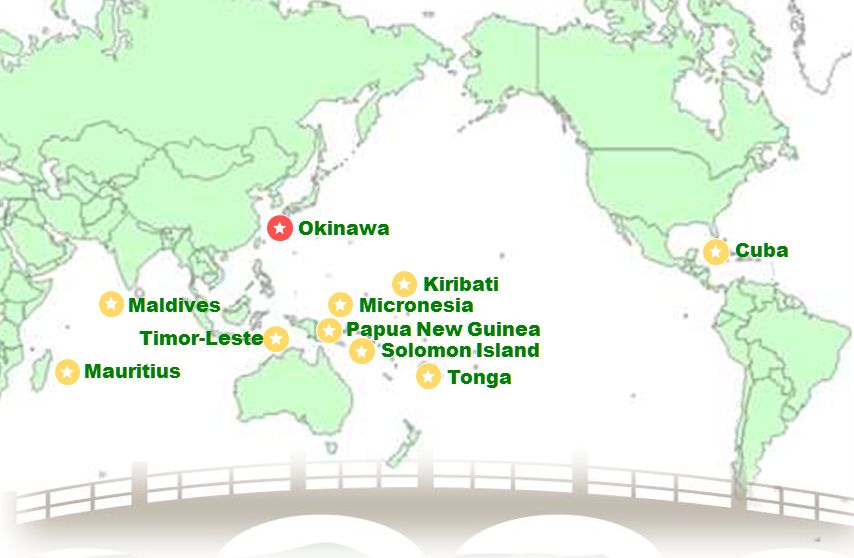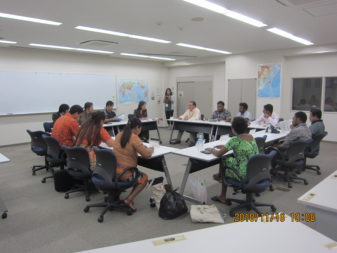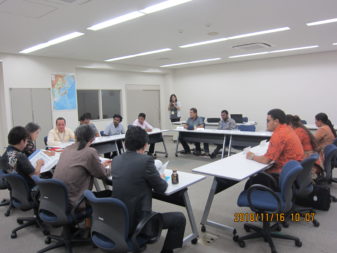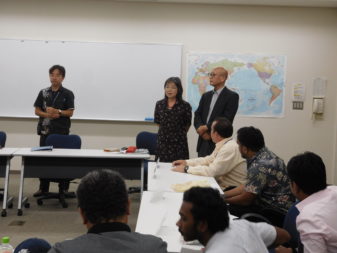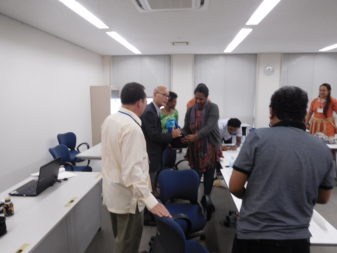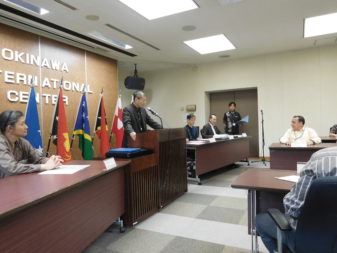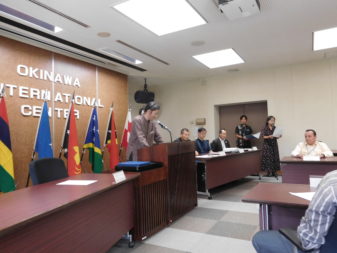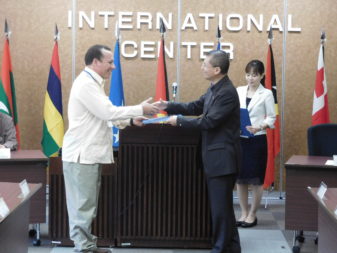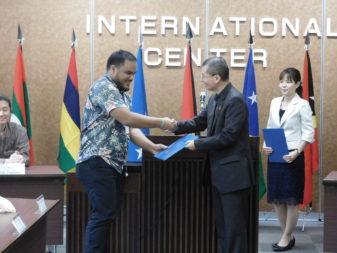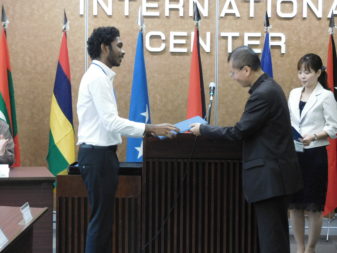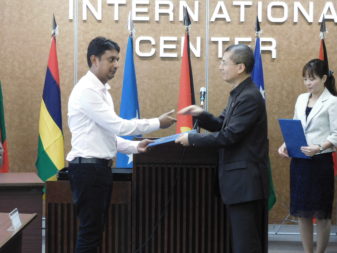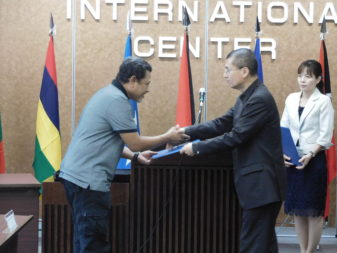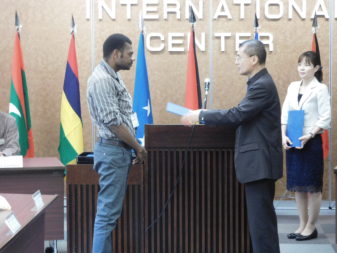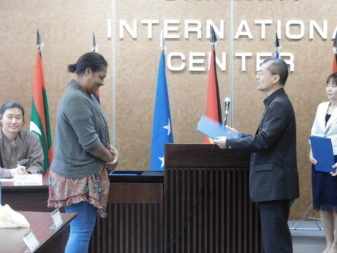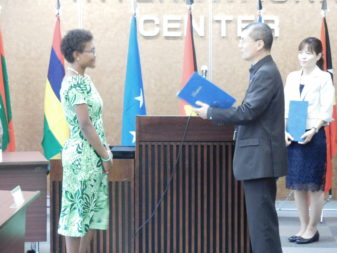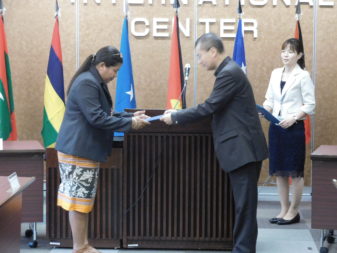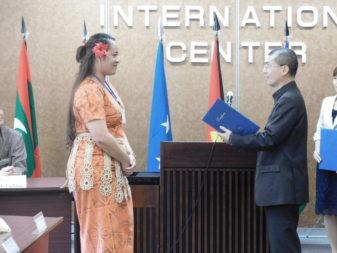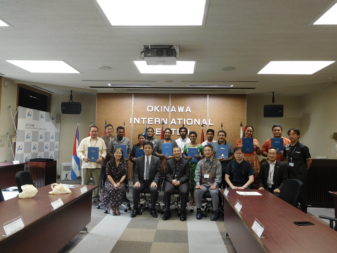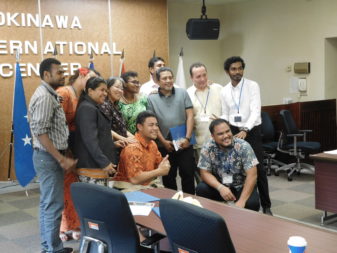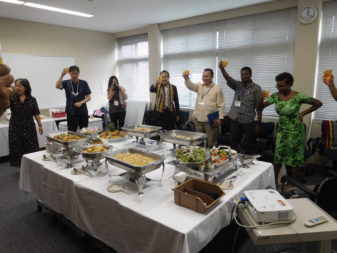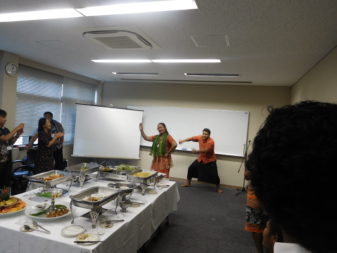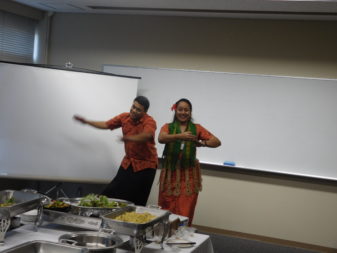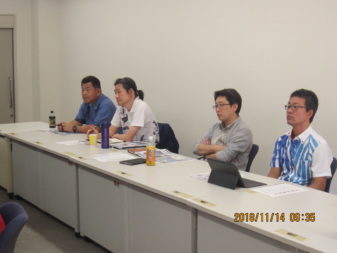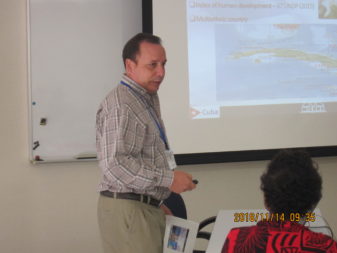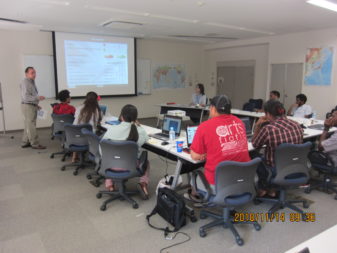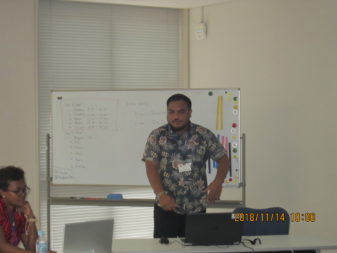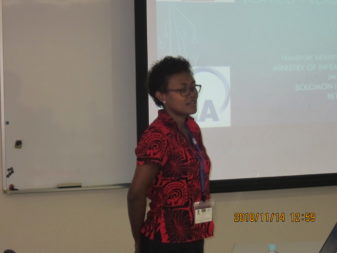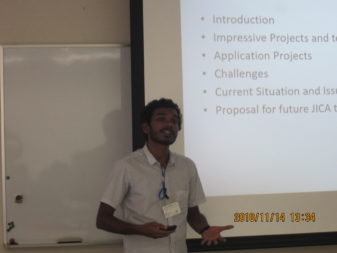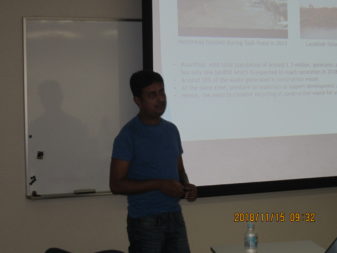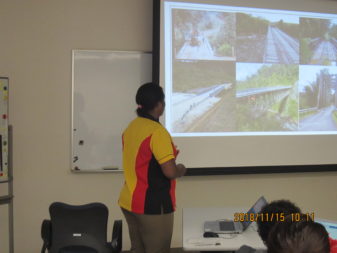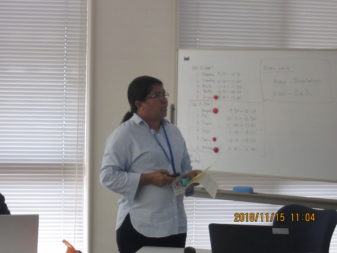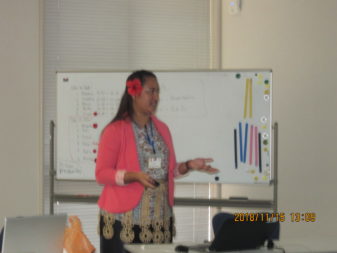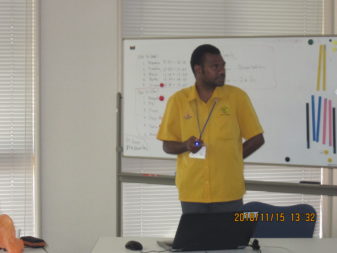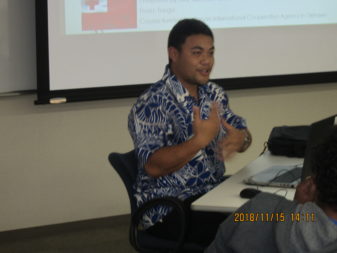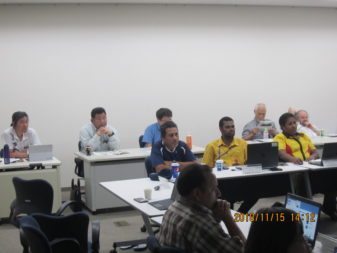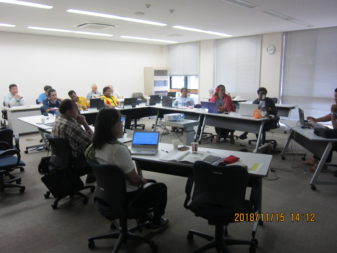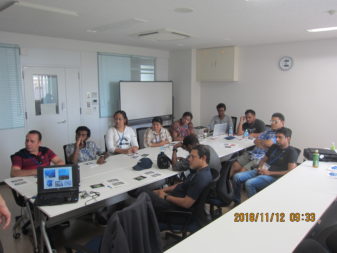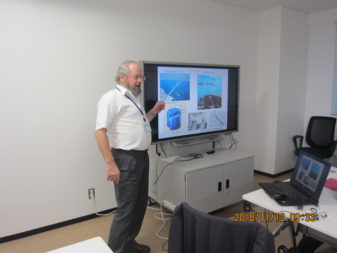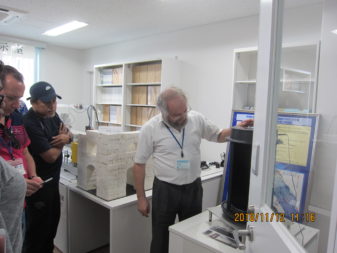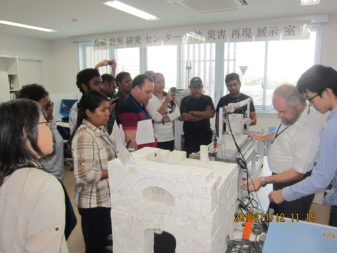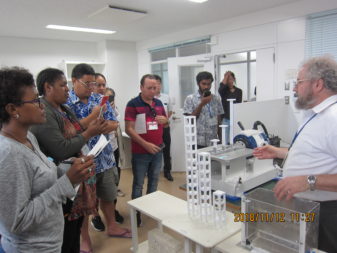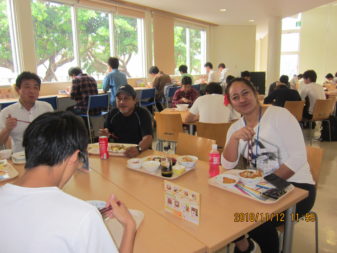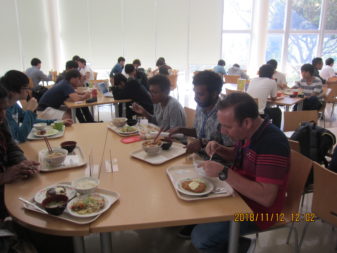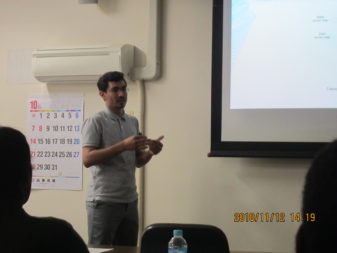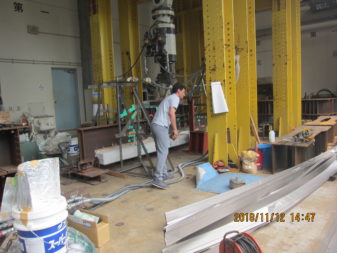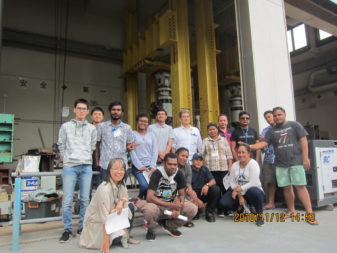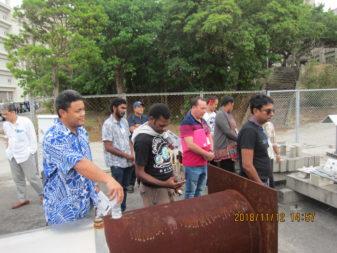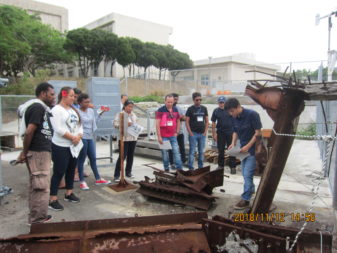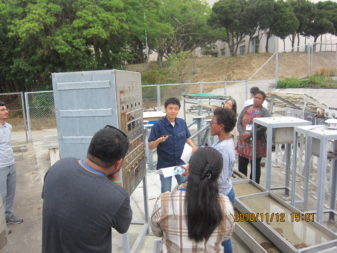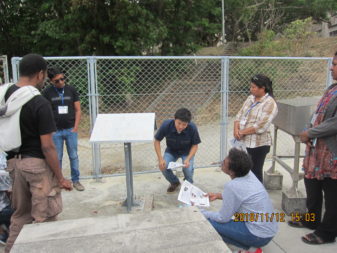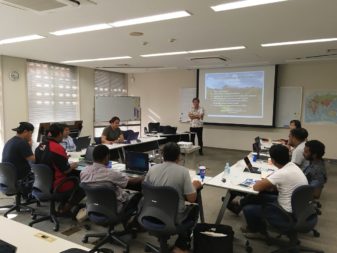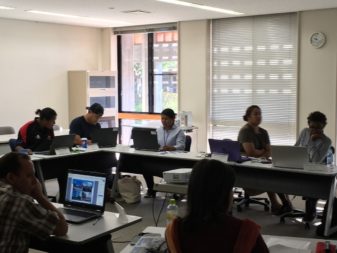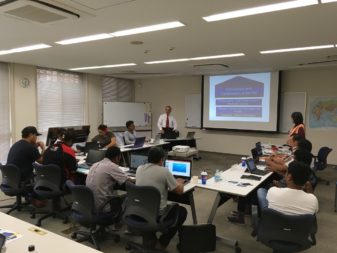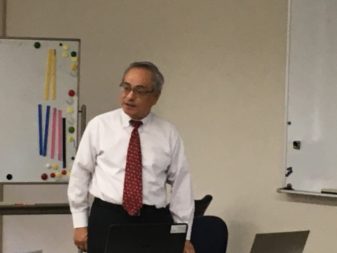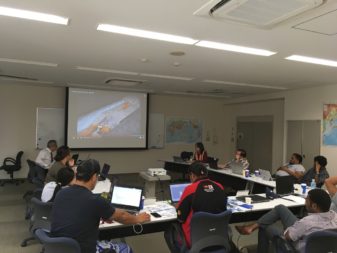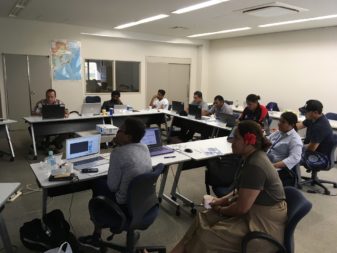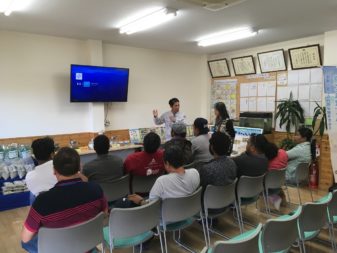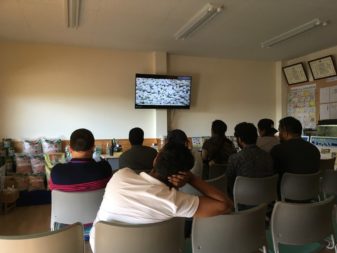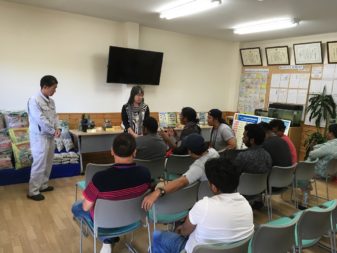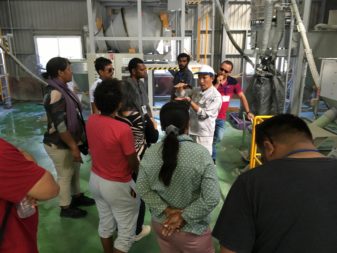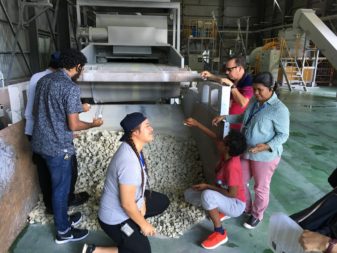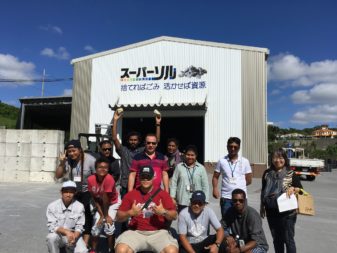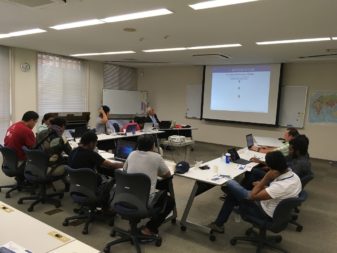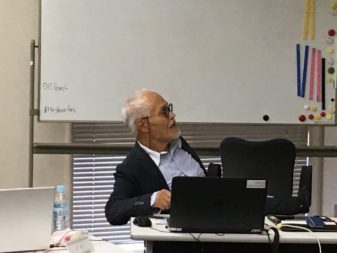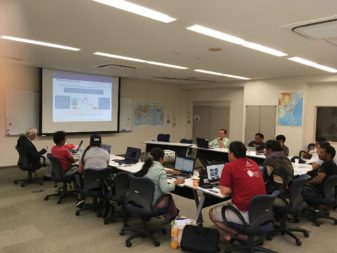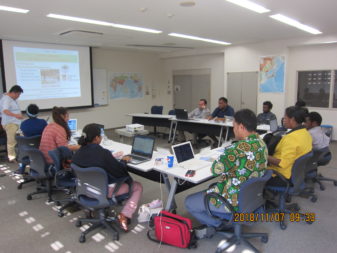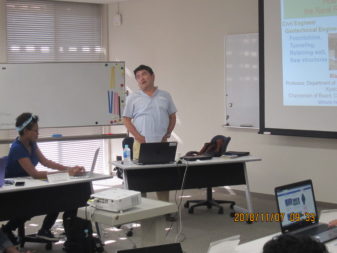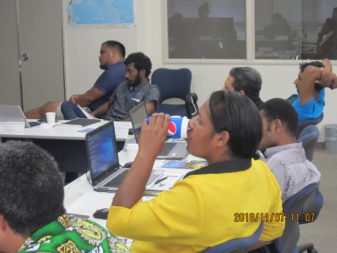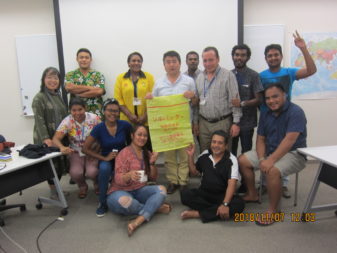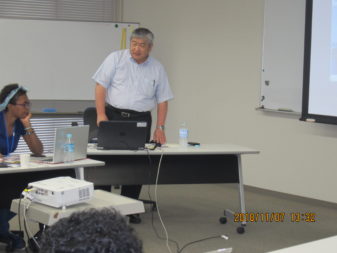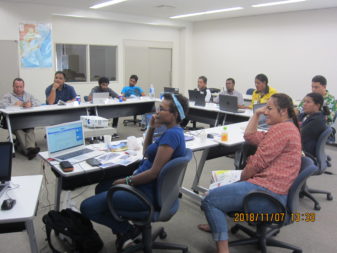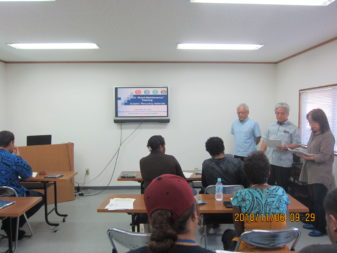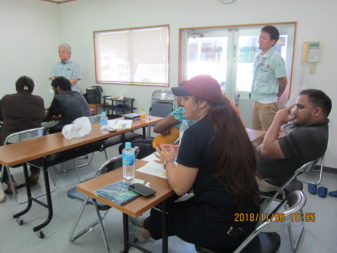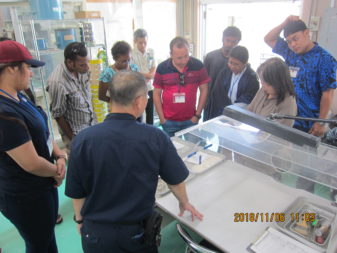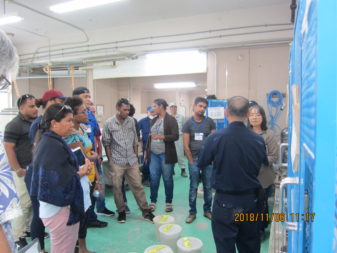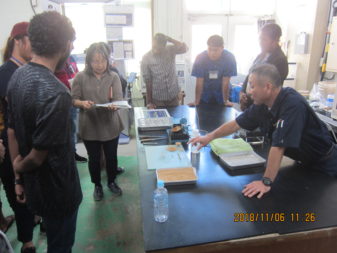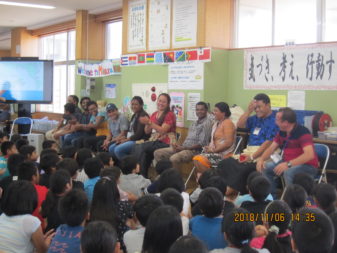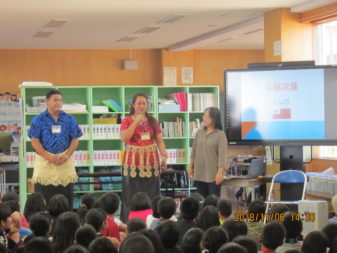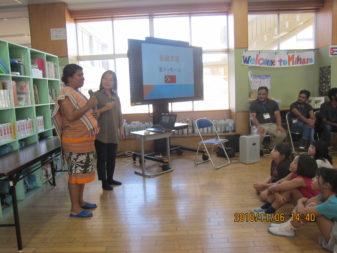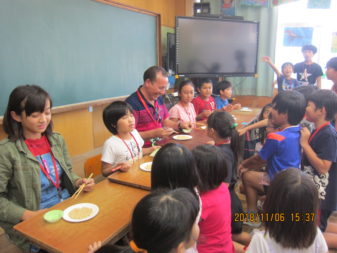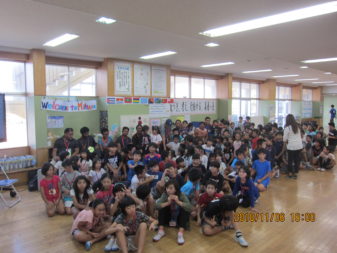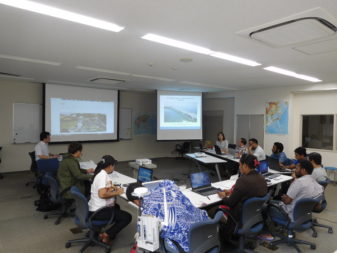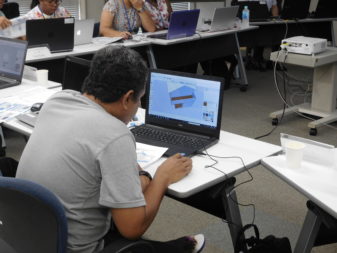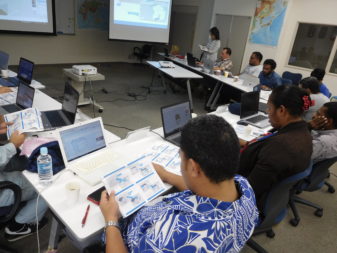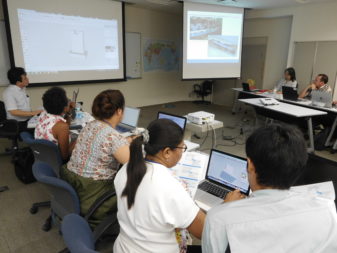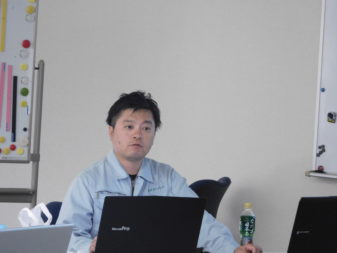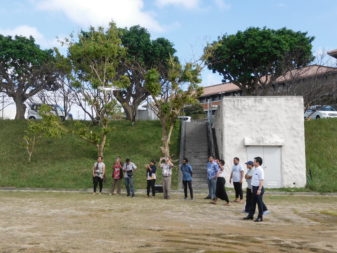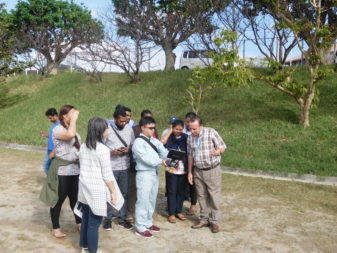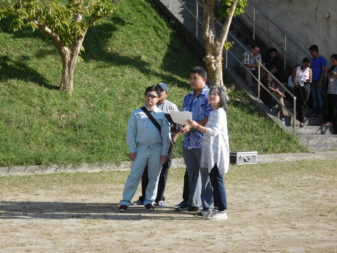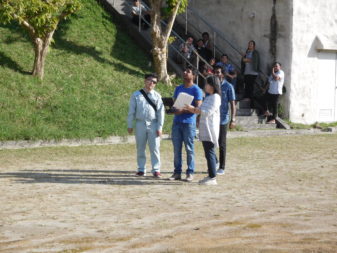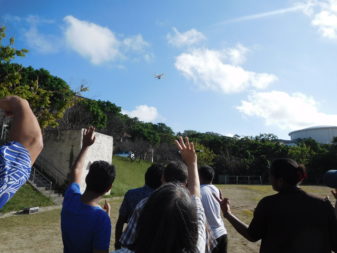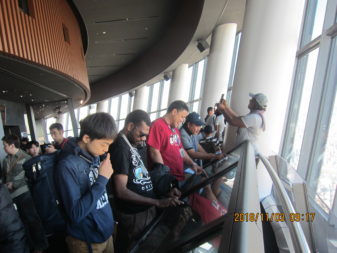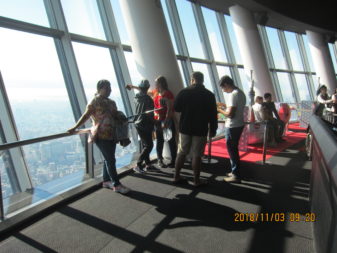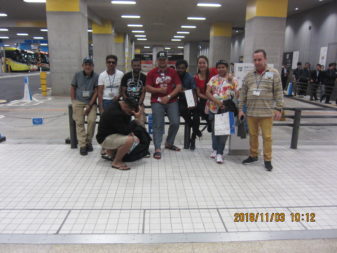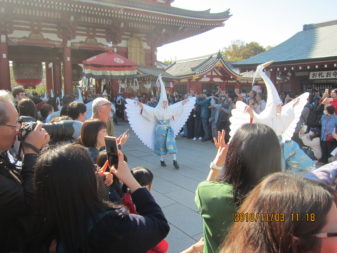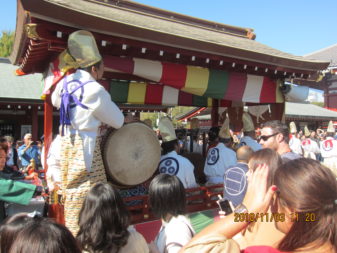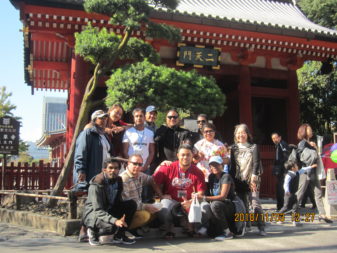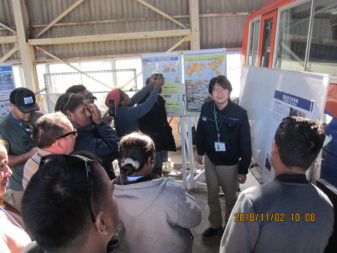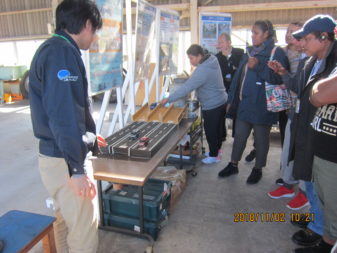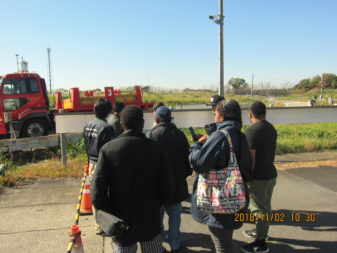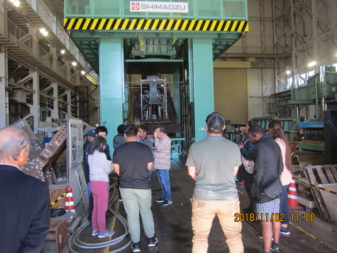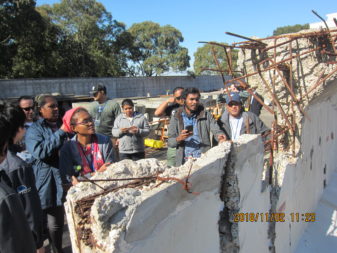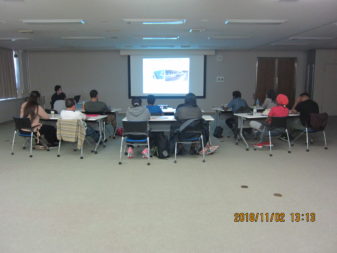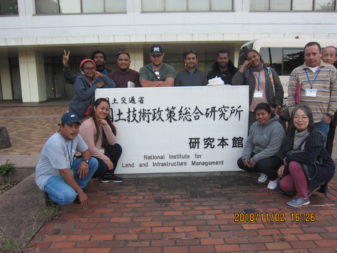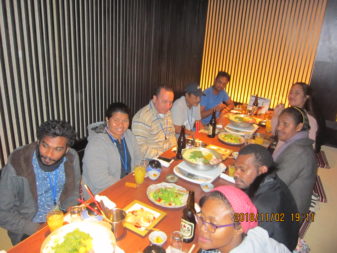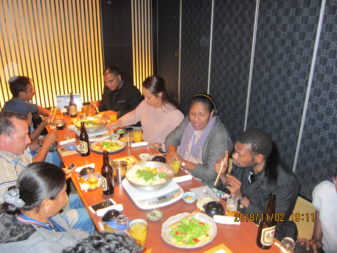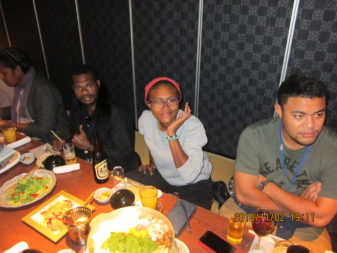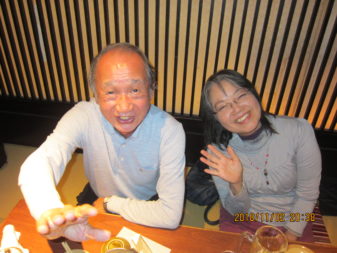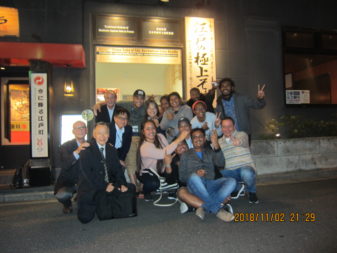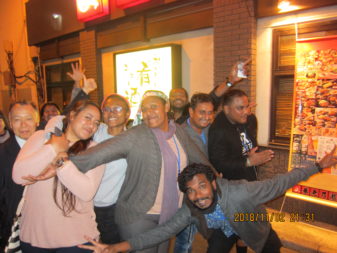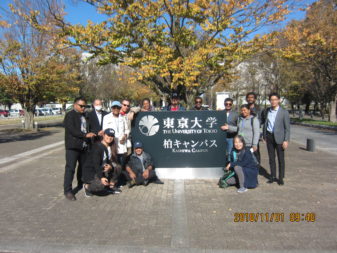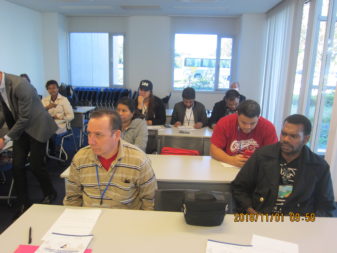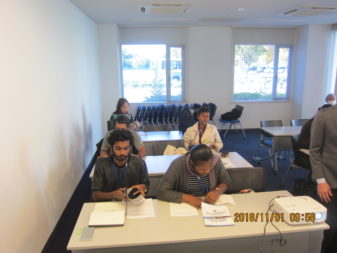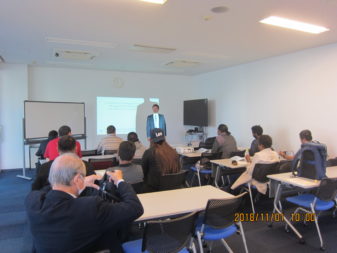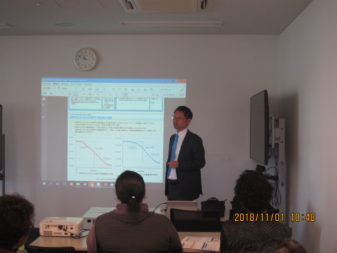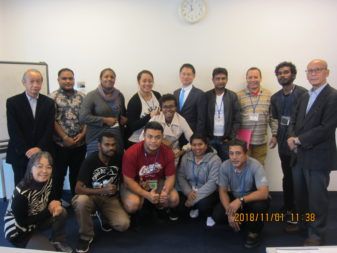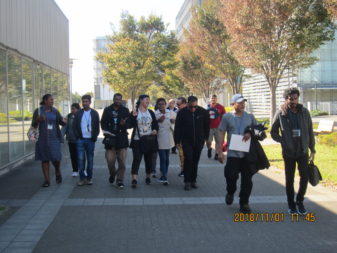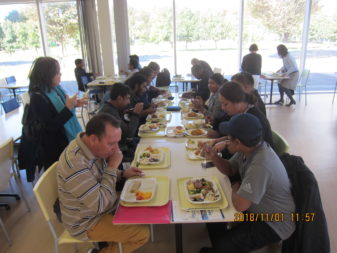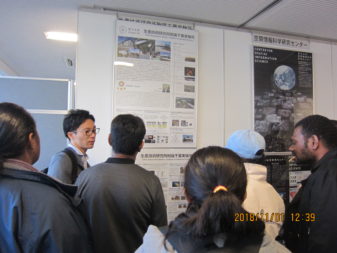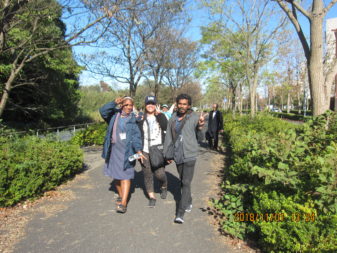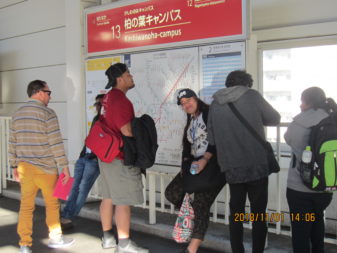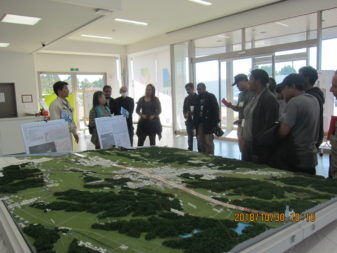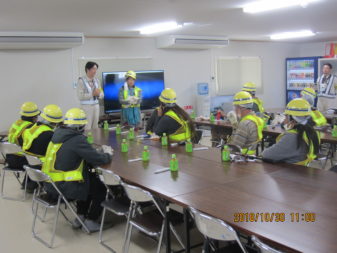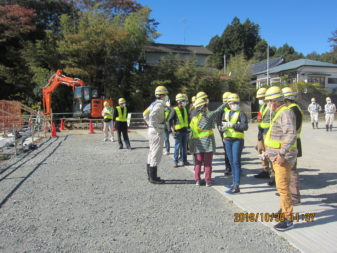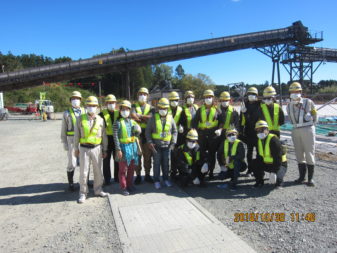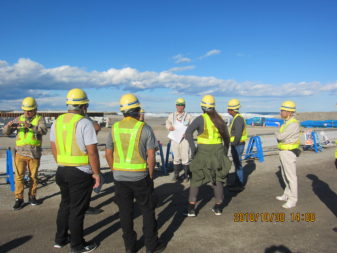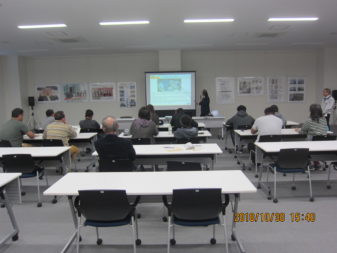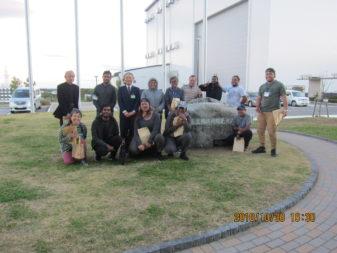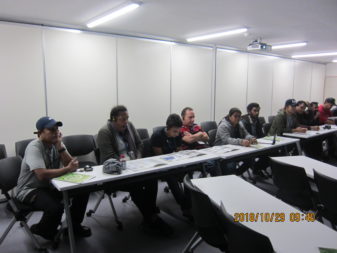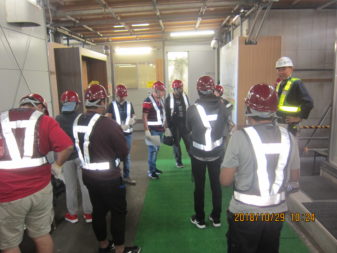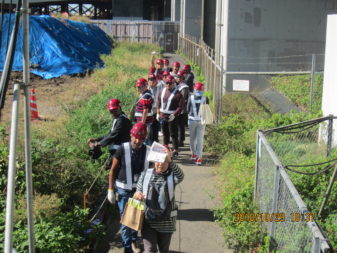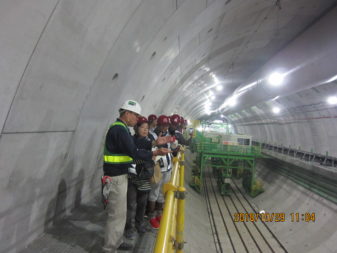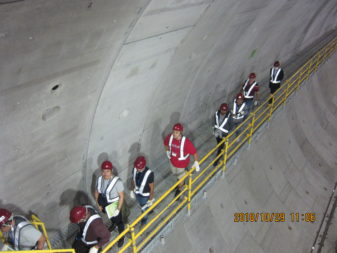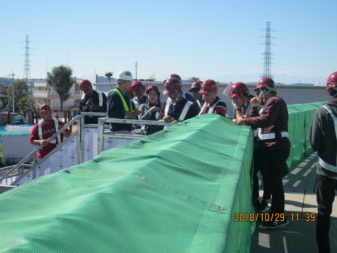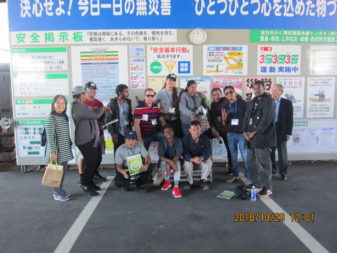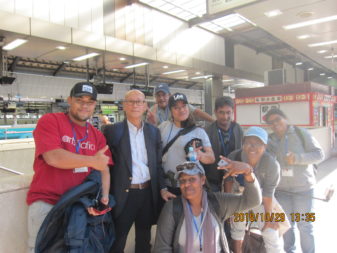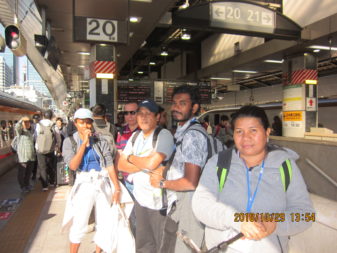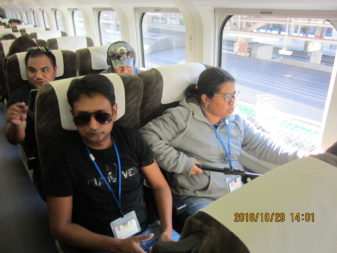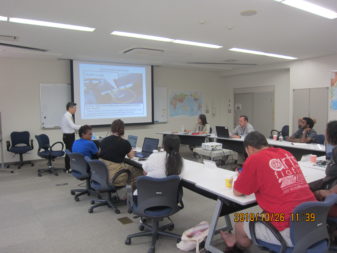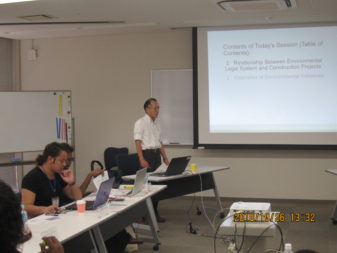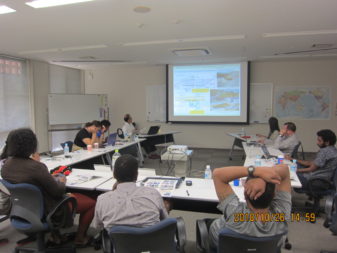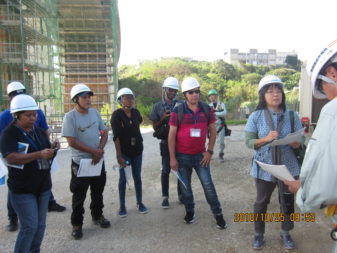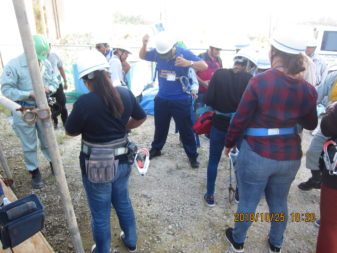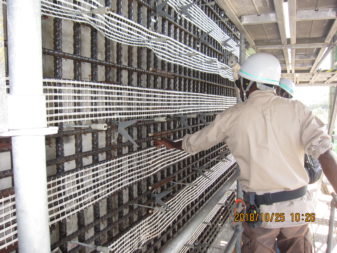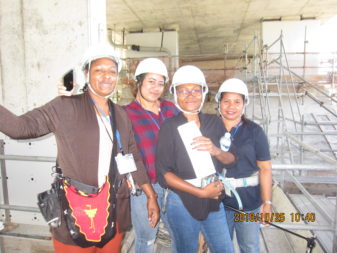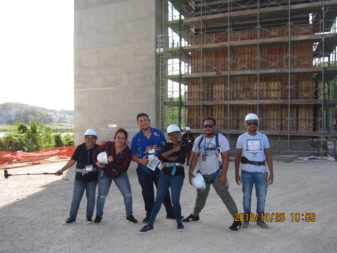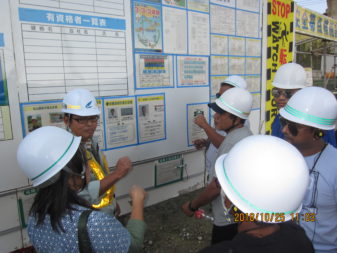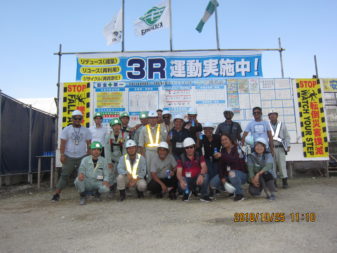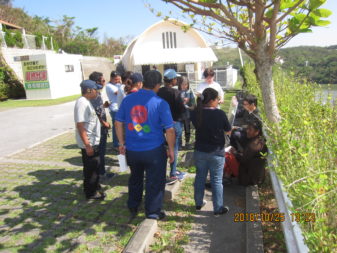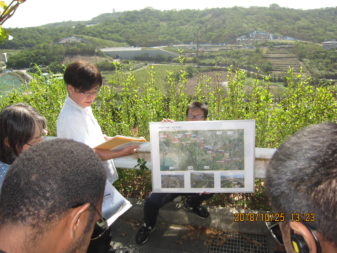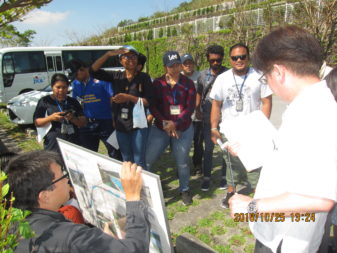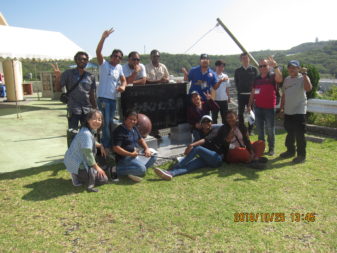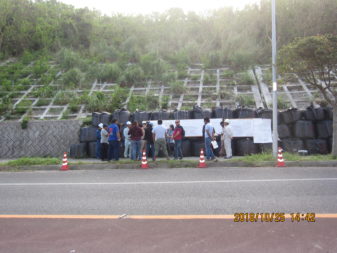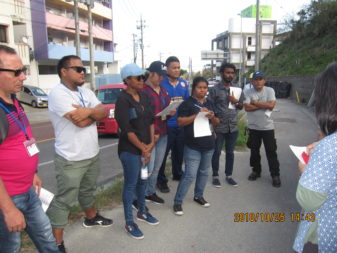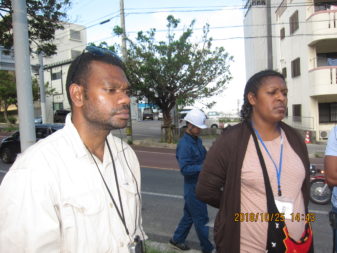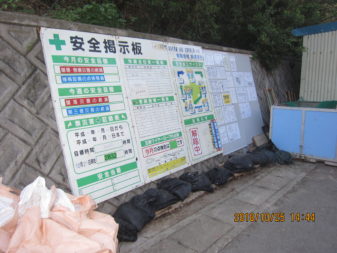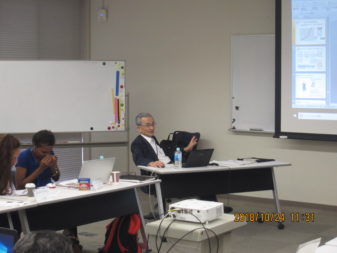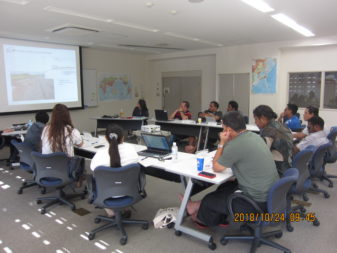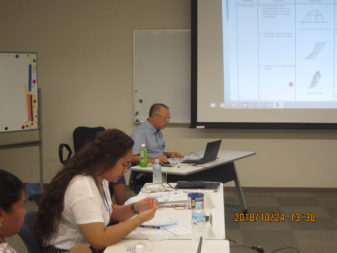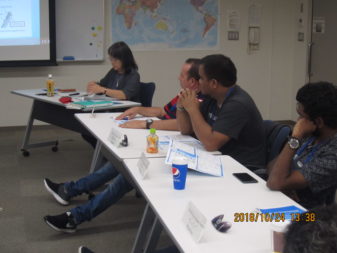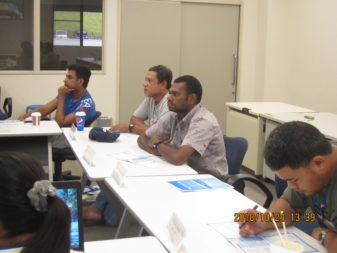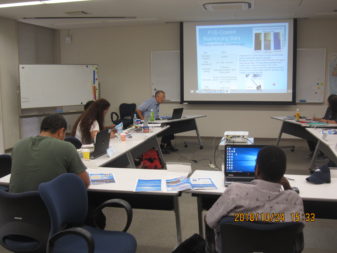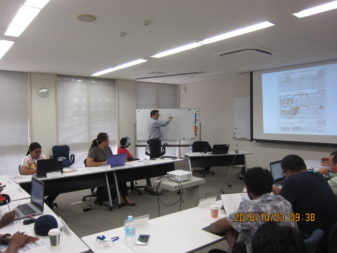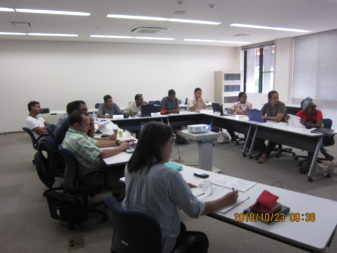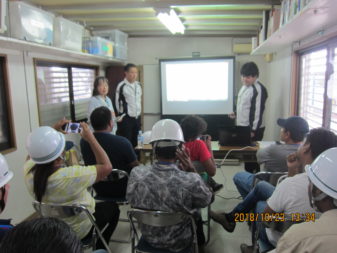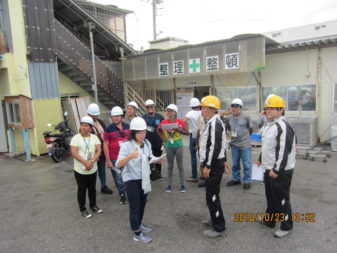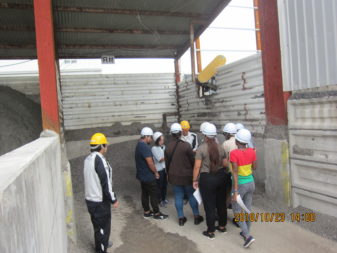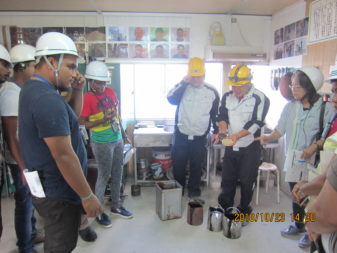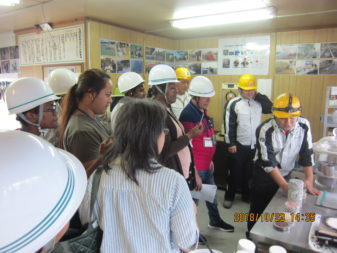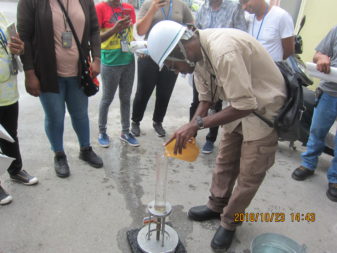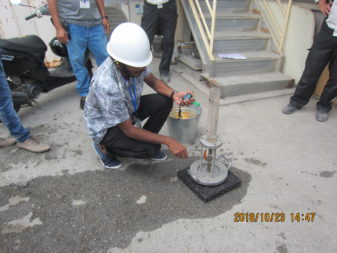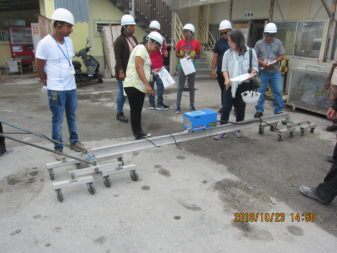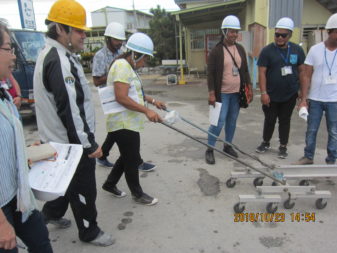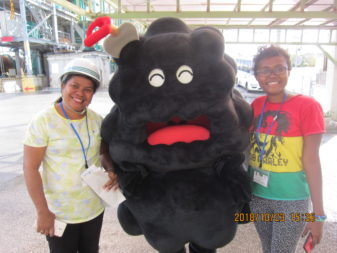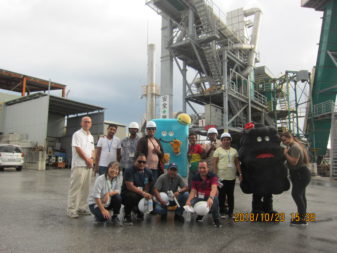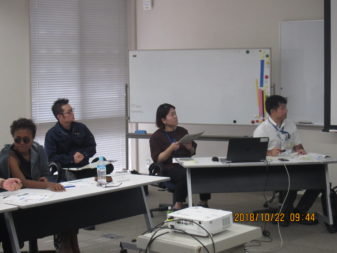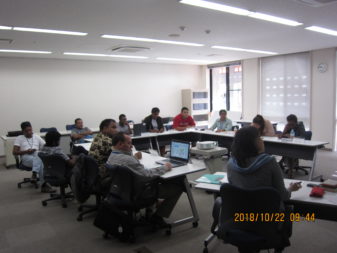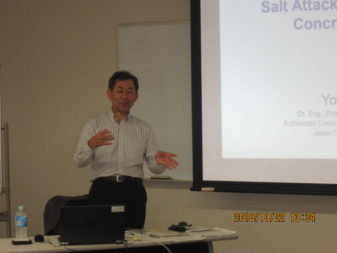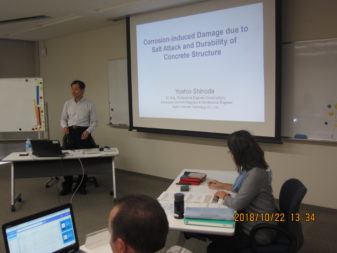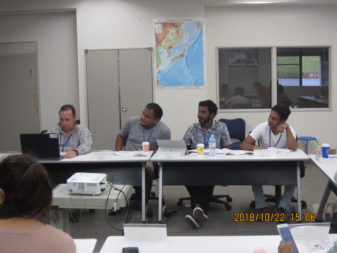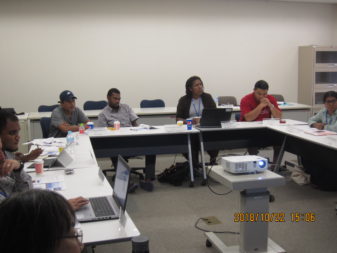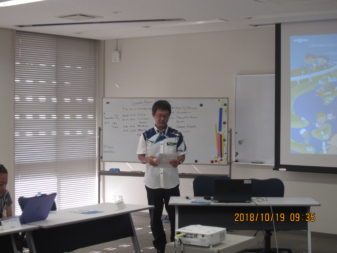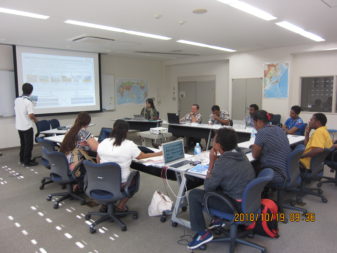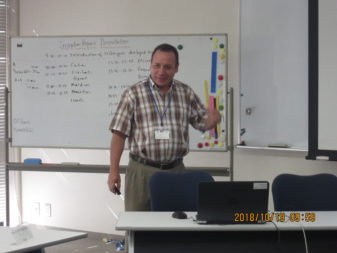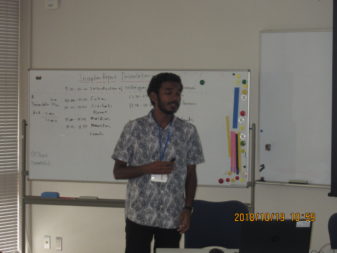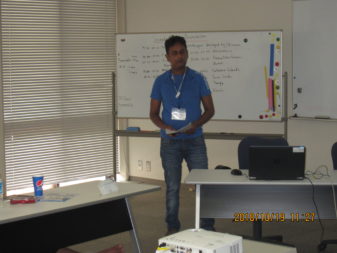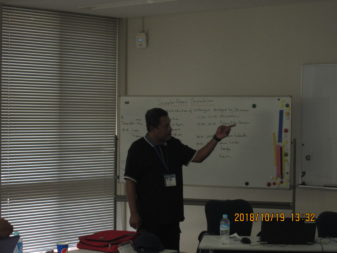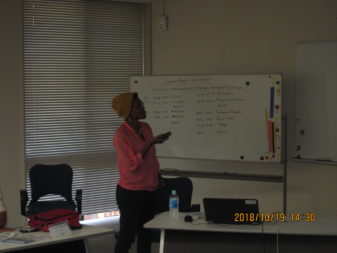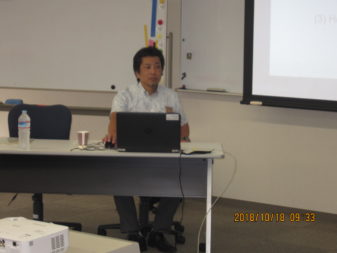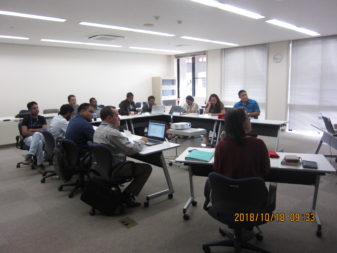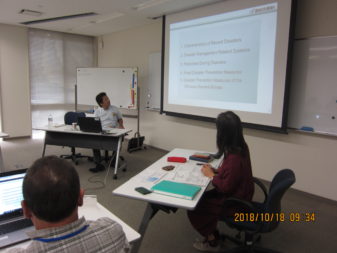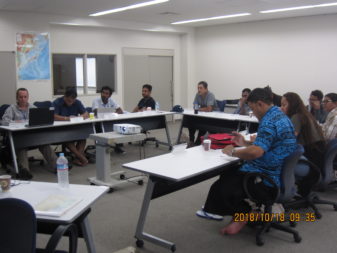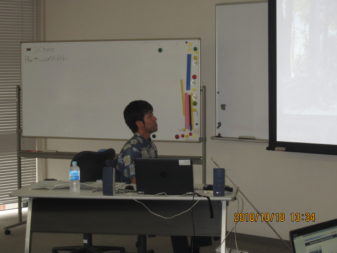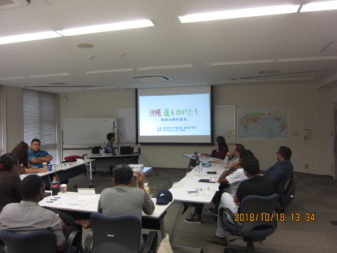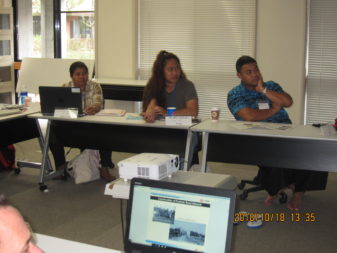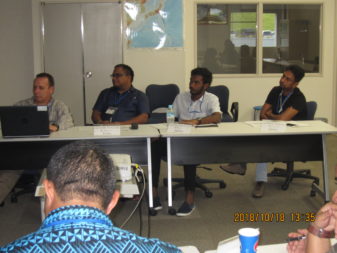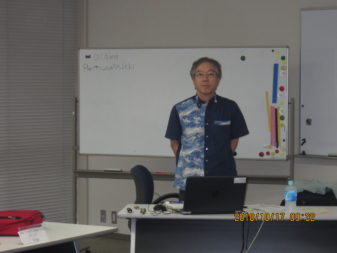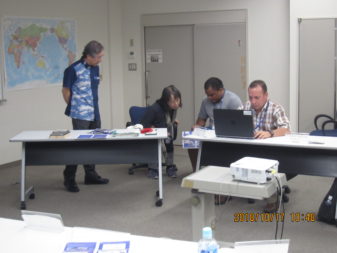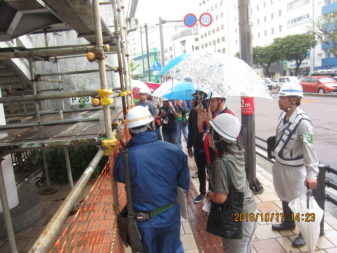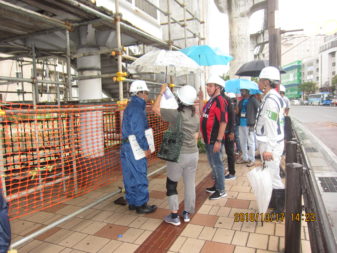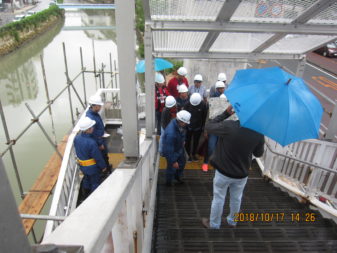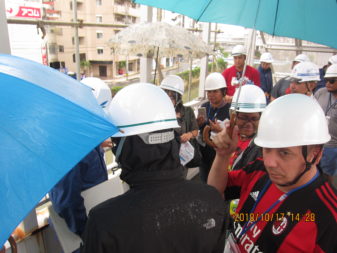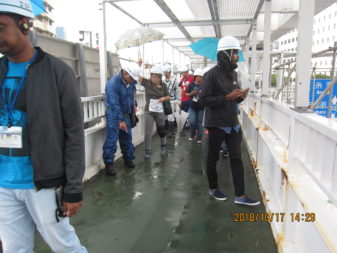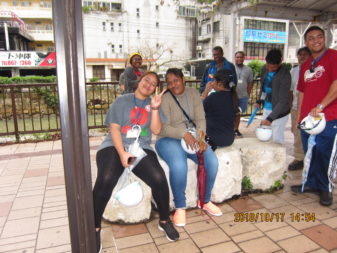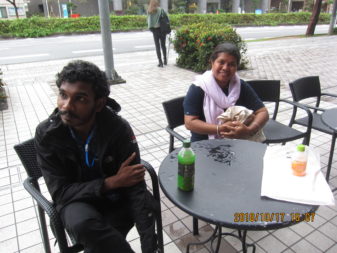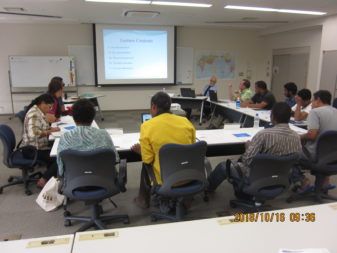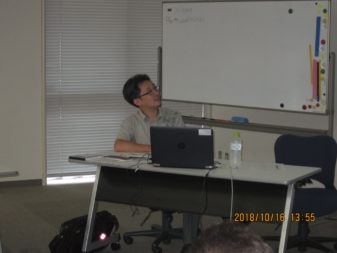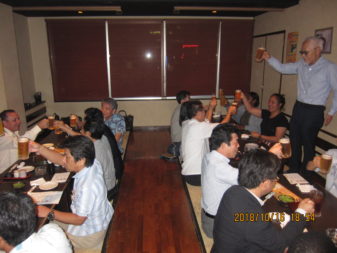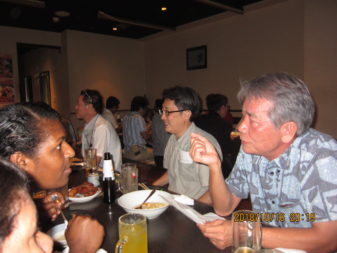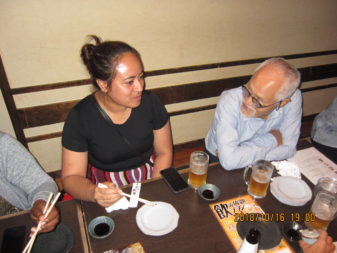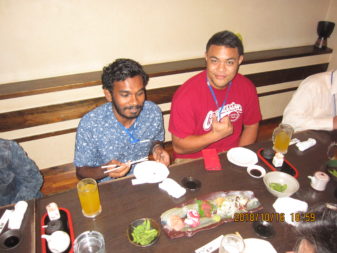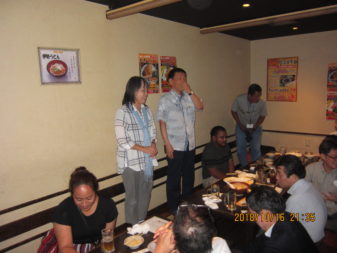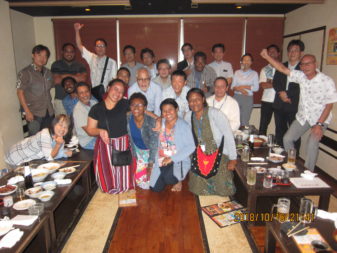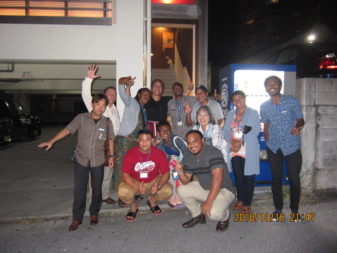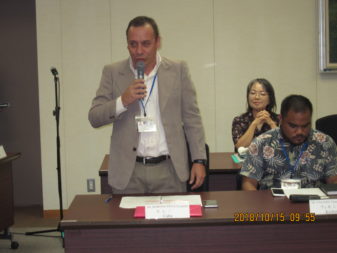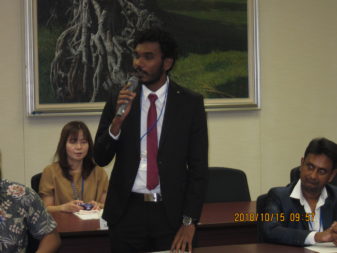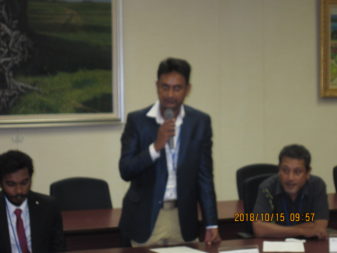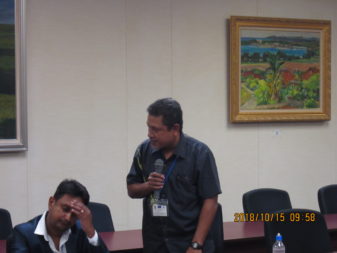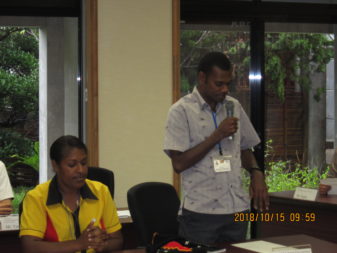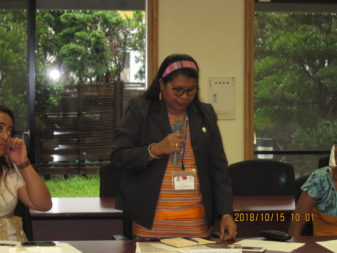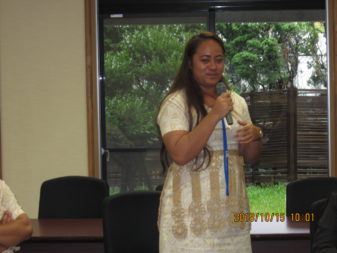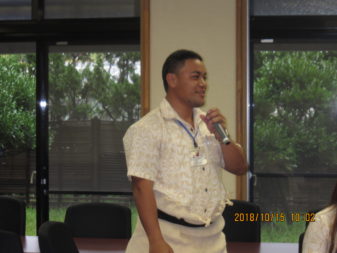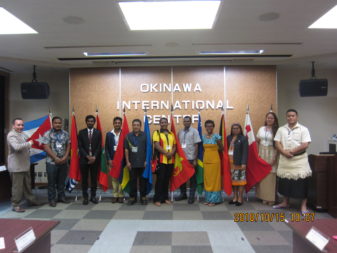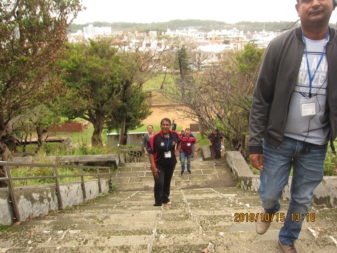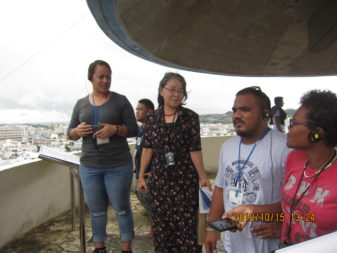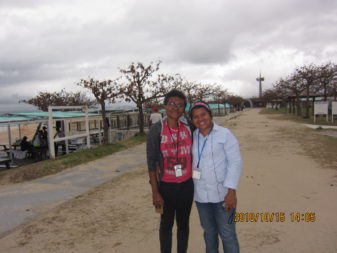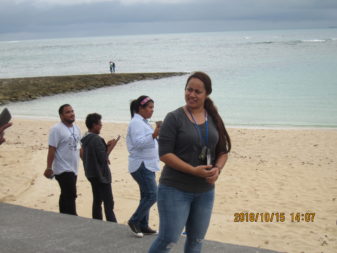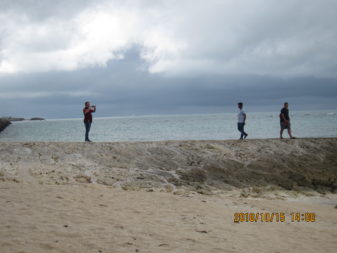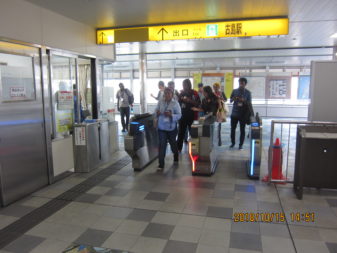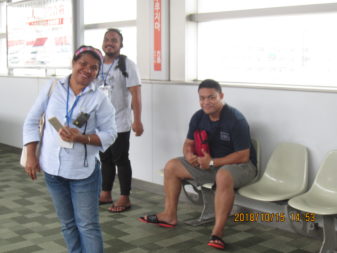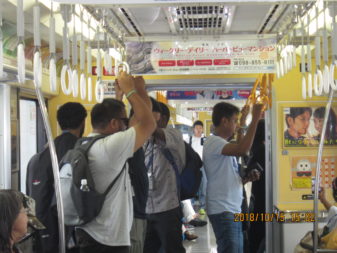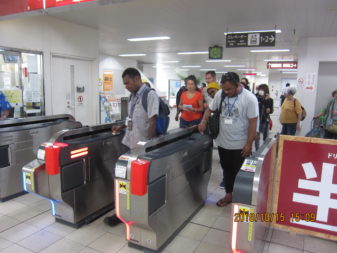2018 JICA Group and Region Focused Training in Road Maintenance and Management (C)
2018年度 JICA課題別研修:道路維持管理(C)コース
NPO法人グリーンアースでは国際協力事業の一環としてJICA沖縄センターより委託を受け、昨年度に引き続き2018年度課題別研修「道路維持管理(c)」コースの研修を実施します。
今回の研修ではキューバ・キリバス・モルディブ・モーリシャス・ミクロネシア・パプアニューギニア・ソロモン諸島・東ティモール・トンガの9ヶ国から計11名の研修員が、日本・沖縄での道路維持管理技術を学ぶ予定です。
(2018.10.15-11.16)
2018.11.16
The entire training program was completed by yesterday. Evaluation meeting was held at 10:00 today to get feedback from each participant. The training program was highly evaluated with some suggestions for founding the detailed field training course (Waste treatment method, Drone & 3D, Traffic planning, Structure design and calculation, Safety management at construction site, etc.). The Closing ceremony was held at 11:30, followed by farewell party. Everyone enjoyed the last memorable moments at the party while watching the slideshows created by JICA officer and Tongan dance by participants from Tonga.
昨日で全ての研修プログラムが終了し、本日は朝10時から「Evaluation Meeting」と称し、各研修員から本コースに対する評価を聞きました。研修は満足度の高い評価を受けると同時に、さらに詳細な分野の研修コース(廃棄物処理、ドローン&3D、交通計画、構造物設計計算、現場安全管理 など)の創設を望む声が寄せられました。
11:30からは閉講式を行い、その後閉講パーティが行われました。研修中の写真で作成したスライドショーやトンガの踊りなどが披露され、思い出に残るとても楽しい時間を過ごすことができました。
2018.11.14-15
We spent two days for presentation of participants’ summary reports. They summarized what they have learnt during this training in the report and presented to audience. The audience who were invited to give comments and questions to the presentations were Hon. Prof. Yabuki (University of the Ryukyus), Prof. Aydan (University of the Ryukyus), Mr. Mochizuki (Senior Officer for Planning and Coordination at Okianwa General Bureau), Mr. Nishizato (Chief Engineer at Civil Engineering Dept., Okinawa Pref. Gov.), and Mr. Matsuda (Director of Planning Section, Okinawa Shimatate Association). The reports also included the technical issues of each country and suggestions to this training which will be reflected to the future curriculum. We found that the preventive measures, preparedness and response for disasters, e.g. earthquake, tsunami, and flood, were thecommon issue for many countries.
14日、15日はサマリーレポートの発表会でした。研修員がこの研修で学んだことを各自レポートに纏めて発表しました。コメンテーターとして、矢吹名誉教授(琉球大学)、藍檀教授(琉球大学)、望月企画調整官(沖縄総合事務局)、西里主任技師(沖縄県土木建築部)、及び松田課長(しまたて協会)にお越し頂き、各研修員のプレゼンに対して質疑応答をしました。各国の技術的な課題や本研修への提案も発表して頂きましたが、これからの研修会で検討して参ります。地震・津波・洪水等の災害に対する未然防止対策、備えや対応が各国共通の課題として述べられました。
2018.11.12
The group attended a lecture, “Road Engineering II”, given by Prof. Omar Aydan at a conference room of Integrated Innovation Center for Community Building. In his presentation, he showed many pictures illustrating damages to infrastructure (road, bridge, tunnel, slope, embankment) in Japan, in particular, and in the world. He introduced examples and elaborated on the issues in road maintenance, non-destructive tests, and new design techniques utilizing Finite Element Method and drone. He then invited the group to his laboratory to show simulation tests of earthquake and tsunami.
In the afternoon, Dr. Shimozato, Associate Professor, spoked about salt attack in Okinawa in his lecture at a conference room in Department of Engineering. One of his graduate students from overseas presented about hist study on load test on bridge girders. Then the faculties showed us their research equipment such as 100t load test machine and exposure test facility.
午前は、琉球大学地域創生総合研究棟会議室で「道路工学Ⅱ」藍檀オメル教授の講義でした。道路を中心にした橋、トンネル、法面や盛土等の日本や世界各国の被害状況を写真で数多く紹介し、道路メンテナンスの課題、非破壊試験、及び有限要素法やドローンを活用した新たな設計方法等の事例を示しながら解説しました。後半は、地震、津波等の発生を再現できる実証設備に移動し、いろんなシミュレーションを行って頂きました。
午後は、工学部2号館の小会議室で下里哲弘准教授から沖縄の塩害状況の講義、及び外国の留学生から橋梁桁の載荷実証研究の発表を行って頂きました。その後、大学構内の100t載荷実験設備や暴露試験施設等を見学し、助教の方々に説明を受けました。
2018.11.9
In the morning, the group had a lecture titled “Road Landscape in Okinawa” delivered by Mr. Ken Kohagura, a counselor at Asahi Construction Consultant Co. Ltd. He pointed out problems with road landscape design in Okinawa and elaborated on new strategies showing actual examples. Participants asked many questions about the maintenance and management of street plants.
The lecture in the afternoon, Mr. Nishikawa, Representative Director of NDC Co., Ltd., gave a lecture on “Introduction and construction of NATM”. Given that many of the participants’ had never been faced with the need of tunnel construction, to explain about the design and execution of mountain tunnel construction, he chose to illustrate the basics of tunnel construction by showing video and animation so that the participants would find it easy to understand.
午前は(株)朝日建設コンサルタントの古波蔵技術顧問による「沖縄の道路景観」と題した講義でした。沖縄県内における道路景観形成上の問題点や新たな取組みを具体的な事例をもって説明されました。研修員からは沿道の植栽の維持管理に関する質問が多くあがりました。
午後は(株)NDCの西川社長による「NATMの概論と施工」と題した山岳トンネルの設計・施工についての講義を受けました。母国においてトンネル建設の必要性が少ない研修生が多い状況に配慮し、基礎的な話をビデオやアニメを使ってわかりやすく解説する工夫をしました。
2018.11.8
In the morning, the group visited Trim Co. Ltd., a waste glass recycling plant. This company produces Super Sol, multi porous light-weighted formed material. From the company’s promotional video and explanation given by Mr. Kawai, Sales Promotion Section, we learned about the characteristics and usage of Super Sol. Then we were escorted to the interior of the plant to study the specifics of production procedure. Participants were owed with the company’s successful business strategy and with their highly distinctive manufacturing techniques.
In the afternoon, participants joined a lecture given by Prof. Yabuki, Emiretus Professor at University of the Ryukyus. He discussed on maintenance engineering of steel bridge (countermeasures against corrosion ofsteel bridge). He elaborated on the environment which causes steel bridge to corrode, and its mechanism based on verified data. He explained that Okinawa is the most suitable site for experiment for verification as its natural environmentis harsh on steel bridge more than other places in Japan. He showed various anti-corrosive measures and important points in maintenance and inspection, developed based on the knowledge relating to corrosion.
午前は廃ガラスのリサイクル工場株式会社トリムの見学でした。まず、ビデオで廃ガラスを粉砕、粉砕、焼成、発砲させた多孔質軽量発泡材であるスーパーソルの特徴や用途の説明を営業推進室の川合さんから受けました。その後、工場内で実際の製造過程を学びました。リサイクル事業がしっかりとビジネスとして成立していることや独創性の高い一連の製造技術に研修員から称賛の声があがりました。
午後は鋼橋維持工学(鋼橋の劣化対策)をテーマに琉球大学矢吹名誉教授の講義でした。鋼橋劣化の環境とそのメカニズム等について実証データを基に解説され、日本の中でも鋼橋にとって最も厳しい環境にある沖縄は最適な実証試験場であるとし、その腐食に関する知見から生み出された様々な防食対策と維持管理・検査の重要なポイントを説明されました。
2018.11.7
The lecture in the morning was given by Prof. Kimura of Graduate School of Kyoto University on “How to Maintain the Rural Road by Ourselves”. He shared his experiences and achievements of NGO activities, developed under his leadership, in many countries especially in Africa. He emphasized the effectiveness of use of “do-nou” to maintain unpaved roads of rural areas. He also stressed on the importance of road among different infrastructures by giving actual overseas examples, showing video. His talk with good sense of humor attracted participants’ attention throughout the lecture.
In the afternoon, Mr. Yoshihiko Ueno,Director of Construction Technology of Toyama City gave a lecture on “Bridge Management”. He discussed that Japanese social trend has been shifted from “age of infrastructure construction” to “age of maintenance and management” and stressed on the importance of maintenance and management skills (skill of making decision) of structure manager. He also emphasized the significance of “human resource development in public, academic, and public sectors” as Japan faces the issue of aging of structures. “The only source of knowledge is experience” said by Albert Einstein.
午前は、京都大学大学院の木村教授による「住民参加型未舗装道路整備」の講義でした。講師自らNGO活動でリーダーシップを発揮した、アフリカを中心とした数々の世界各国での実績を紹介し、「土のう」が未舗装道路整備等にいかに有効かを力説されました。また、インフラの中で占める道の重要性について、各国の実事例を挙げたり、ビデオで説明されました。講義中、研修員は講師のユーモアある話に熱中していました。
午後は、富山市の建設技術統括監の植野芳彦さんによる「橋梁マネジメント」をテーマとした講義を聞きました。日本はインフラ構築から維持管理の時代になり、維持メンテの重要性等、管理者としてマネジメント(判断の必要性)を学びました。老朽化対策の課題に関し、「官・学・民における人材育成」を強調されました。(何かを学ぶのに、自分で体験する以上に良い方法はない。-アインシュタイン)
2018.11.6
The group visited Okinawa Prefectural Center of Construction Technology in the morning. There, two lectures were given, “Recycling Materials” and “Paving Material Test”. Participants developed interest in the tests as the explanation given by Mr. Akamine was in detail and easy to understand, and asked questions. They showed interest in recycled materials as well and asked many questions such as the usage of the recycled materials and the prices.
午前は沖縄県建設技術センターでの講義と試験設備の見学でした。講義は「リサイクル資材」(講師)と「舗装材料試験」(赤嶺講師)の2テーマでした。今回は、赤嶺講師のきめ細かい分かりやすい丁寧な説明と試験機材に興味を抱いて、熱心に聞いて、質問をしていました。また、リサイクル材にも各研修員とも関心を示し、具体的な用途や価格を含めた質問を繰り返していました。
2018.11.5
The topic given today was “3D-CAD and Drone” instructed by Mr. Suzuki, Mr. Miyara, and Mr. Miyagi from Okabe Maintenance Co. Ltd. Participants practiced making 3D modeling using SketchUp, a 3D design software, in the morning. They installed the software to their PCs and did practical modeling of a house and bridge pier.
In the afternoon, after covering the outline of 3D geological survey with aerial photo taken by drone and some matters that required attention for operating drone, each participant had an experience of flying drone at OIC playground. In classroom, they checked the aerial photos, movie taking by drone, and 3D models. Participants became well aware of the significance of survey with use of drone.
本日は(株)オカベメンテの鈴木・宮良・宮城講師による「3D-CADとドローン」と題した講義でした。午前は3Dデザインソフト:SketchUpによる3Dモデリング実践講習で、研修員は個々のパソコンにインストールした3Dソフトを使って、住宅や橋脚のモデリングを行いました。
午後はドローン空撮による3D地形測量の概要とドローン操縦に当たっての注意事項を学んだ後、グラウンドにおいて各研修員がドローン操縦を経験しました。ドローン空撮を終えた後には空撮写真や動画・3Dモデル等を確認し、ドローン測量の優位性を認識することが出来たようです。
2018.11.3
Last day in Tokyo, the group observed Asakusa area to study community road where visitors can appreciate its history, tradition, art and culture. We first went up to the observatory of Tokyo Sky Tree tower, 350m from sea level, to observe streets in Tokyo near and far from the tower and beautiful sceneries of Japan. Then we walked through Rokku- Kogyogai and Sensoji Temple, enjoying different cultural features contained in the downtown Tokyo. To our surprise, we had a wonderful encounter of a special parade of “Shirasaki-no-mai” (Dances of White Heron). We gazed in the performance, feeling as if we looked at an old painting. The whole schedule of Tokyo tour was tight but we arrived to its end. We landed in Naha before 7pm.
東京視察の最終日は、歴史と伝統・芸能文化に培われた街づくり、及び道路の事例として浅草地区の視察でした。まず、新タワーであるスカイツリーの350m展望台から東京の街並みや遠くの日本風景を楽しみ、次に浅草寺から六区興行街を散策し、様々な色合いの残る下町らしさを堪能しました。偶然にも、白鷺の舞の行列の行事が行われていて、優雅な絵巻に酔いしれていました。強行スケジュールにも関わらず、午後7時前に全員那覇空港に無事帰ってきました。
2018.11.2
We visited National Institute for Land and Infrastructure Management (NILIM) and Public Works Research Institute (PWRI) in the morning. We were shown the test run field, paved road test field, experimental facilities for structure members, and stockyard of removed members from bridges all over Japan. The staff in charge of each section explained in detail. As an experience, our bus run the test bank at the speed of 100km/h which was one exciting event. We saw in awe the Japan’s largest loading test machine which presses test structure member by the force of 30MN.
In the afternoon, we had a lecture, “Planning of highway Bridges”, delivered by Mr. Okada, Chief Researcher at NILIM, followed by another lecture, “Pavement Technologies and Management in Japan”, by Mr. Kawakami, Researcher at PWRI.
In the evening, all participants joined a dinner party in a restaurant in Akihabara, “Dofuuro”. Despite the worry if participants may like Japanese stew, they finished all food including ramen. The party was filled with friendly atmosphere that some participants sang songs with dances.
午前は国土技術政策総合研究所及び土木研究所の施設見学で、試験走路・舗装走行実験場・構造物実験設備・及び橋梁撤去部材でそれぞれ担当者から説明を受けました。高速バンクをマイクロバスにて100km/hで走行する体験に感動し、また国内最大30MN大型構造材万能試験機には圧倒されていました。
午後は、前半は国総研岡田主任研究官による「道路橋の維持管理」、及び後半は土研の川上研究官による「舗装のマネジメント」と題した講義でした。
また夜には、秋葉原駅近くの「土風炉」で午後7時から全員参加の懇親会でした。意外にも鍋料理が好みのようで、最後のラーメンまで残らず完食でした。研修生の歌や踊り?も飛び出し、和気藹々の雰囲気でした。
2018.11.1
We had a lecture given by Professor Horita on “A Guideline for Bidding & Contract Systems for Management & Maintenance Projects: the Concept of Comprehensive Contracts” in a meeting room of library building, University of Tokyo Kashiwanoha Campus in the morning. He presented that Sasago Tunnel Incident was a trigger of establishment of road maintenance system and elaborated on new system of bidding for road maintenance contract. Participants answered to the questions posed by Prof. Horita and listened carefully to the lecture as they compared the system of bidding and contract of their countries and that of Japan.
After lunch, Mr. Inoue, a graduate student, showed us university facilities on the campus. There was a surprising event that we accidentally saw Prof. Kajita, a novel prize winner in physics, in front of his laboratory building. At the end of the campus tour, Mr. Inoue escorted us to a conceptual model of eco-friendly community installed in front of Kashiwanoha Campus Station.
午前は、東京大学(柏の葉キャンパス)の図書館の会議室で、堀田教授の「日本の維持管理工事の入札制度について」をテーマにした講義でした。まず、先生は、笹子トンネル事故が道路維持制度整備のきっかけになったことや維持管理工事に対し入札の新たな方式について説明しました。研修生は先生の質問に答えながら、自国の入札契約制度と比較し興味を持って聞いていました。
午後は、大学院生(井上さん)の案内で大学構内を歩いて廻りながら説明を受けました。ノーベル物理学賞の受賞梶田先生の研究棟前では梶田先生を偶然見かけ、びっくりでした。最後は、柏の葉キャンパス駅前の環境に配慮した新しい街を大学院生から案内して貰いました。
2018.10.30
We rode on a minibus, and travelled a long distance by transferring several Expressways, then reached to Futaba Town of Fukushima Prefecture which had been designated as “difficult-to-return zone” by Japanese government as it was significantly inflicted by East Japan Great Earthquake. There was a barricade at the entrance of the town, restricting entry of cars and people. We saw the ravaged town with many abandoned houses and buildings. We first had a briefing about the site visits at office, then went to see the interim storage facility of waste and soil generated out of decontamination works, and disposal site in the morning. In the afternoon, we went to a construction site of Futaba interchange of expressway and another work site of revetment at sea and river. The radiation dose was indicated in many points along road and at the site. Participants were interested in the measured value and asked questions.
Then we moved to Naraha Center for Remote Control Technology Development. This center promotes researches to promote and operates the remote control technology with robots to be used in the decommissioning of the Fukushima Nuclear Power Plant. Participants had a chance to experience virtual reality system and were cheered with 3-dimentaional images. No photographing inside the center was allowed.
マイクロバスで高速道路を乗り継いで、東日本大震災による被害を受け帰還困難区域である福島県双葉町内に入り、バリケードで立入りが規制され、また廃墟のような建物や住宅等異常な状況を視察しました。午前は、事務所で概要説明を受けてから、除染等に伴う廃棄物処理、中間貯蔵施設、処分場等の見学でした。午後は、まず、双葉インターチェンジ工事、河川、護岸(防潮堤)工事現場の見学でした。道路や現地では、現在の放射線量が標示されていて、研修生はその数値に関心を示し、質問をしていました。
その後バス移動して、楢葉遠隔技術開発センターの視察でした。ここでは、福島原子力発電所廃止措置でロボットの遠隔技術の運用・改良を促進しています。研修生は、バーチャルリアリティ(VR)システムでは模擬空間を体験し、歓声を上げていました。尚、センター施設内は撮影禁止でした。
2018.10.29
We observed the construction site of Main Line Tunnel (south bound) Tomei North Section, ordered by NEXCO East Japan Expressway Co. Ltd. It was the Japan’s largest tunneling work with 15.8m of outer tunnel diameter (14.5m inner tunnel diameter) and 9,155m of tunnel length. Last year, the work was still at the initial stage of excavation. But in this year, it has been making a steady progress since April, and advanced up to about 500m. Mr. Mochiki, vice director of the main tunneling work, briefed us on the work outline in meeting room. Then all participants wore helmet and safety vest, and were escorted to the actual tunneling site. As it was the first time for the participants to see the shied tunnel work, they showed great interest in it and were overwhelmed with its hugeness. After the observation, the group moved from Tokyo to Koriyama by shinkansen. Upon arrival, some participants put on coats as they found Koriyama was much colder than Tokyo.
NEXCO東日本発注の、東京外郭環状道路本線トンネル(南行)東名北工事の現場見学でした。外径15.8m(内径14.5m)・延長9,155mの日本最大のシールド工事です。昨年は初期掘進が終わったばかりでしたが、今年4月から掘進を開始、順調に進み、約500m掘り進んでいました。まず、会議室で持木副所長から本工事の概要の説明を受けた後、研修生は全員ヘルメット・チョッキを身に着け、現場を案内して頂きました。初めてのシールド工事現場に興味津々で、また、何もかもスケールが大き過ぎる現場にビックリ仰天の様子でした。シールド現場見学終了後、東京駅から新幹線に乗って郡山に向かいました。東京よりかなり気温の低い郡山にコートを羽織る研修生もいました。
2018.10.26
The lecture in the morning was titled, “Safety and Health Management in Japan”, delivered by Mr. Takashi Fukuda. In the first half of the lecture, participants learnt related laws such as Labor Standards Act and Industrial Safety and Health Act, and the background of establishment and major contents of these laws. Later half of the lecture was in practical style where the lecturer showed pictures of actual work sites and asked the participants to assume they were patrolling to find out unsafe arrangement or behavior. In most of the cases, participants gave unerring answers rated highly by the lecturer.
In the afternoon, Mr. Fukashi Oguchi gave a lecture on “Environment Conservation Technology for Road Maintenance”. At first, he explained about legal structure of environment conservation in Japan and how these laws relate to construction sector. In the later half, he explained the possible measures for conservation including actual procedures of turbid water treatment and water disposal.
午前は、福田隆さんの「日本における安全衛生管理」の講義でした。前半は、労働基準法、労働安全衛生法等関係法令について学び、関連法律が制定された経緯や主な内容の説明を受けました。後半は、研修員が安全パトロールの査察者として、写真を見ながら不安全設備、不安全行動をチェックするという実習形式でした。ほとんどの事例に対し、研修生から的確なコメントが得られ、講師から高い評価を貰っていました。
午後は、小口深志さんの「道路維持管理における環境問題」の講義でした。前半は、日本の環境の法体系の整備、及びそれらと建設事業との関わりについて学びました。後半は、環境への対応方法について、水質汚濁、廃棄物等に関する具体例も含めて学びました。
2018.10.25
In the morning, the group went out to observe the aseismic reinforcement work on arch-type bridge in Haebaru ordered by Okinawa General Bureau. At first, a staff from Nanbu National Highway Management Office briefed us an outline of the work, then we walked up the scaffold at 30 m above the ground to observe the actual work. All participants wore safety belt (harness) and slowly moved up the stairs, watching their steps carefully. It was the RC multiple span continuous balanced bridge. The reinforcement work needed to be conducted as to fit to the current standard that is to be resistant to large-scale earthquake. For instance, individual bars to be connected to the bridge main body is done alternatively.
The site the group visited in the afternoon was the work ordered by Okinawa prefectural government. We looked at road under construction from the hill of Ozato Memorial Park. The staff from Nanbu East Road Construction Management Office explained the outline, how this road construction would contribute to promotion of southern region community, and other effects out of the work. It will be completed 8 years later. Then we moved to Urasoe-Nishihara line road to observe a disaster prevention work. The work was determined because retaining wall had cracks after severe rain last year, and further damage was expected to occur if left it without any treatment. Use of restraining pile (H steel pile) was adopted to prevent landslide. The participants were interested in the pile drive by the tower installed in provisional staging.
午前は、沖縄総合事務局発注の南風原アーチ橋耐震補強工事の現場見学で、南部国道事務所から現場説明後、高さ約30mの足場に上って作業箇所を視察しました。全員安全帯を装着し、足元を確認しながら昇降設備をゆっくりと登って行きました。構造はRC多径間連続バランスアーチ橋で、現行基準である大規模地震対応の耐震補強であり、橋脚に「しなやかさ」を与え、地震のエネルギーを吸収するように補強する工事です。例えば、本体構造物への差し筋は1本毎となっています。
午後は、沖縄県発注の工事現場視察でした。まず、南部東道路の施工現場を大里メモリアルパークから眺めました。南部東道路建設現場事務所から工事概要の説明があり、南部圏域の振興に寄与する地域高規格道路工事、事業の経緯や整備効果等の説明がありました。完成は8年後とのことです。次は、浦添西原線の災害防除工事の見学で、昨年の大雨で擁壁に亀裂が生じて、放置すると災害を引き起こす危険があり、その対策工事です。抑制杭(H型鋼)による地滑り防止対策工法が採用されています。研修生は、仮設足場上での櫓による杭打ち工事に興味を持っていました。
2018.10.24
The lecture in the morning was given by Mr. Morimasa Furuki, Senior Advisor at Japan Society for Civil Engineering on “Pavement Design and Damages in JICA Project Sites”. He stressed the importance of quality management of asphalt plant, and introduced how to design appropriate pavement according to the traffic load using formula, and actual cases of pavement repair in JICA project sites. At the end, he showed some cases of pavement failure and their countermeasures.
In the afternoon, Mr. Kazuo Mita, president of Choju Hokyo Doko (meaning, long-life reinforcement earthwork in Japanese) Co. Ltd. delivered a lecture on “Slope Technology”. He shared an actual case when an earthquake at seismic intensity of 6 caused a collapse of banking in Tomei Expressway in 2009, the collapsed region was restored within 4 days (where it usually takes more than 2 weeks to restore). Participants were surprised with the Japan’s high technology of making it possible. Then he showed pictures to illustrate the vulnerability of slope reinforcement works today and stressed the importance of LCC (Life Cycle Cost) and new techniques and products to use to reinforce slopes. Participants were showing their interest in highly durable members.
午前は、(一社)国際建設技術協会の古木守靖顧問による「JICAプロジェクトにおける舗装損傷と舗装設計」と題した講義を受けました。アスファルトプラントにおける品質管理の重要性を中心に、交通需要に応じて適切な舗装道路を公式を用いて設計する方法や、JICAプロジェクトの舗装補修事例などについて説明を受けました。最後に、失敗事例とその対策について説明を受けました。
午後は、長寿補強土工の三田和朗社長に「法面マネジメント」の講義を受けました。まず、2009年の震度6弱の地震により被害を受けた東名高速道路の盛土崩壊箇所を、4日間(通常は2週間以上)で復旧した事例の紹介があり、研修員は日本の技術力の高さに驚いていました。次に、現状の法面補強の脆弱性を写真で見せながら、LCC(Life Cycle Cost)の重要性と法面に関する新たな技術や商品の説明があり、研修員は高耐久性部材に興味を示していました。
2018.10.23
In the morning, Mr. Morita from Maeda Road Construction Co. Ltd. delivered a lecture on “Asphalt Pavement Maintenance Technology”. He explained about the various asphalt pavement damages using actual examples, illustration and photos. In the latter half of lecture, he elaborated on the cases of porous asphalt.
Afternoon session was the observation of asphalt plant owned by Nanawa Co. Ltd. At the beginning, the staff of Nanawa briefed us about the facilities installed in the plant and manufacturing flow. This company installed asphalt storage silo since last year. Then the group was shown the actual facilities and stock yard. Whenever the participants asked questions, Mr. Kishimoto and two other staffs from Nanawa responded to them. In the lab, the group experienced water permeability test and road surface roughness test after they were shown newly developed measurement devices. At the end of the observation, the staff of Nanawa showed their successful works so far in slides and shared their corporate policies. When we were leaving the plant, “Ascon” and “Road”, official characters of the company, appeared and cheered us.
午前は、前田道路(株)の守田部長による「アスファルト舗装保全技術」の講義を受けました。まず、アスファルト舗装の破損の種類について説明と具体的な事例をマンガや写真で紹介しました。後半は、ポーラスアスファルトに関する説明でした。
午後は、(株)七和のアスファルトプラントの見学でした。最初に会議室でプラント各設備と製造フローの説明を受けました。昨年から、新たにアスファルト保存サイロが建設されていました。その後、実際の設備や材料置き場を見学しました。研修員からは見学中に質問が投げかけられ、七和の技術者岸本さんら3名にその対応に当たって頂きました。そして、試験室等で浸透試験を実際に学び・体験し、また平坦性を測定する新しい測定器材の紹介を受けました。最後に会議室で(株)七和のポリシーや実績の説明を受けました。そして、ゆるキャラのアスコン君とロード君に見送られてプラントを後にしました。
2018.10.22
The lecture in the morning was titled, “Road Administration in Okinawa”, delivered by Mr. Nagamine, Chief Engineer, Mr. Kohatsu, Chief Examiner, and Ms. Kawakami, Section Chief at Road Administration Division, Department of Civil Engineering and Construction, Okinawa Prefectural Government. Participants learnt the conditions of road and administration system in Okinawa, routine maintenance duties, various projects, and authorization and permit. The participants showed a special interest in the authorization and shared some cases in their counters. There are some countries who have not established legal structure as an enactment of road act.
In the afternoon, Mr. Shinoda (Dr. Engineering, Professional Engineer, Authorized Concrete Diagnosis & Maintenance Engineer) delivered a lecture on “Corrosion-induced Damage due to Salt Attack and Durability of Concrete Structure” and “Basics of Concrete Pavement”. He started his lecture by asking questions about the basics of concrete. Then he continued explaining in detail the mechanism and progression of salt attack, contributing factors to deterioration and countermeasure technology against salt attack (e.g. use of stainless reinforcement) from the perspective of durability of concrete, asking questions to participants at times. The participants showed their interest in criteria of salt attack and changes in deterioration factors. Then towards the end of lecture, the participants learned the basics of concrete pavement.
午前は沖縄県土木建築部道路管理課の長嶺主任技師、小波津主査、及び川上主任から「沖縄県の道路維持管理業務」テーマに講義を受けました。沖縄県の道路とその管理体制、日常の維持管理業務、各種事業、および許認可等を学びました。最後の許認可に興味を持ち、自国の事例等についての質問がありました。まだ道路法等の整備が遅れている国もありました。
午後は「塩害とコンクリート構造物の耐久性」、及び「コンクリート舗装の基礎」というテーマで篠田さん(工学博士・技術士・コンクリート診断士)の講義でした。コンクリートの基礎についての質問から始まりました。そして、コンクリートの耐久性の観点から、塩害のメカニズムや進行状況、劣化の要因、及び塩害対策技術(ステンレス等)等について、研修生に質問しながら、詳細に解説して頂きました。研修員は塩害の基準や劣化要因の推移に興味を示していました。又最後にコンクリート舗装の基礎についても学びました。
2018.10.19
This day was dedicated for country presentations (road conditions) of the participants. The session was joined by Mr. Yamanaka and Mr. Nishizato from Planning Unit, Civil Engineering Administration Section, Department of Civil Engineering and Construction of Okinawa Prefectural Government who is promoting globalization of enterprise activities of Okinawa. Questions raised by participants or audience including Mr. Nishizato after each presentation helped us find some common issues among countries.
午前午後を通して研修員による道路事情等を含めた各国の紹介でした。沖縄県グローバル化事業を展開している沖縄県土木建築部土木総務課の西里さんや山中さんにも参加いただきました。各発表後、西里さんや研修生間の質疑応答では各国共通の課題が見えてきました。
2018.10.18
The title of morning lecture was “Natural Disaster Prevention System” given by Mr. Uehara, Chief of Disaster Prevention Section, Development and Construction Department, Okinawa General Bureau. He explained about the system of disaster prevention against earthquake, tsunami, volcanic eruption, and severe rain. The participants shared the same concerns and tried to understand the difference in the system of disaster prevention and response between their countries and Japan. They asked for administrative manual (translated into English) for disaster response. As globalization is in progress, we found that some local municipalities translated their disaster response guideline for local citizens into English.
In the afternoon, a lecture, “History of Road Maintenance in Okinawa Prefecture, Future Road Plan” was delivered by Mr. Ina, Chief of Planning and Coordination Unit, Road and Street Maintenance Section, Department of Civil Engineering and Construction, Okinawa Prefectural Government. He first showed a video of “Road Story in Okinawa” narrated by coordinator Ms. Teruya. Then he discussed about the transition of road maintenance of Okinawa in postwar period and after Okinawa’s reversion to Japan. The participants also learned about the future visions of Okinawa.
午前は沖縄総合事務局開発建設部上原防災課長による「道路の防災対策」というテーマでの講義で、地震・津波、火山、豪雨による災害の防災対策の説明がありました。研修生各国は同様の災害に悩まされ、災害時の対応や防災対策が自国とどのように違うのか、熱心に聞いていました。また、多くの研修生から災害時の行政のマニュアル英訳版の要望がありました。グローバル化が進む中、住民に対する災害時の対応ガイドラインの英訳版を作成している地方自治体はありました。
午後は沖縄県土木建築部道路街路課企画調整班の稲主任によるテーマ「沖縄県の道路整備の歴史、今後の道路計画」の講義で、まず「沖縄道ものがたり」のビデオをCDN照屋さんの英訳で視聴しました。その後、沖縄県の戦後の日本復帰後に行った道路整備状況と、今後のビジョン等の説明を聞きました。
2018.10.17
The lecture in the morning was titled “Operating and Maintaining National Highways” delivered by Mr. Sunagawa, Director of Department o Development and Construction, Okinawa General Bureau. Participants were listening to the lecture with high interest especially in routine maintenance (e.g. inspection) and emergency response.
The participants went to see repair work of Izumizaki Pedestrian Bridge, a work ordered by Okinawa General Bureau in the afternoon. Rain had continued falling since the morning, so we had a briefing given by the contractee of the work with opening umbrellas. The participants were asking questions such as guarantee period or about scaffold. Then, the group walked on the bridge observing the condition of it, and asking specific questions such as how to select a method of repair depending on the degree of corrosion.
午前中は「国の道路維持管理」をテーマに、総合事務局開発建設部の砂川課長からの講義でした。研修生は、道路の日常管理(点検等)や災害時への対応に興味を持って聞いていました。
午後からは総合事務局発注の国道58号線「泉崎歩道橋補修」の現場見学でした。朝からの雨が激しい中、傘をさしながら、発注者から工事概要の説明を受けました。保証期間や足場についての質問がありました。その後、歩道橋を渡りながら、現場で現物を見ながら、研修生は腐食の程度によりどのような補修方法を選択するのか等、具体的な質問を数多くしていました。
2018.10.16
In the morning, Dr. Yabuki, Emeritus Professor at University of the Ryukyus, delivered a lecture on “Basic Concept of Infrastructures”. Participants were listening attentively to his lecture. He gave some examples in Okinawa (e.g. Irabu Great Bridge) and in Tokyo (e.g. Tokyo Sky Tree). At the end of the lecture, Dr. Yabuki led a discussion with participants.
In the afternoon, Mr. Mochizuki, Planning Coordination Officer at Department of Development and Construction, Okinawa General Bureau, Cabinet Office, delivered a lecture, “Road Network of Japan and Okinawa”. Participants were interested in the topic and asked many questions after the lecture.
In the evening, NPO Green Earth hosted a welcome party for the participants in a restaurant in Naha city. The party was joined by the lecturers of our training who belong to national government, Okinawa prefectural government, university and private corporations. We all enjoyed the joyous evening together with local foods and drinks (some enjoyed the taste of Orion Beer and Awamori!).
午前は「社会基盤整備概論」のテーマで琉球大学矢吹名誉教授の講義がありました。沖縄の事例(伊良部大橋)やスカイツリーの事例等を取り入れながらの講義に研修生は、熱心に聞き、最後に研修生も含めたディスカッションを行いました。
午後は「日本と沖縄の道路ネットワークについて」をテーマとした沖縄総合事務局開発建設部の望月企画調整官の講義でした。皆さん、日本と沖縄について関心が深く、講義終了後に質問が相次ぎました。
又、夜には那覇市内の居酒屋で懇親会を開催し、国、沖縄県、大学、及び民間会社の講師の方々とも一緒にオリオンビールや泡盛を飲みながら楽しい時間を過ごしました。
2018.10.15
First day of the training. After opening ceremony in the morning (started at 9:30), Mr. Suzuki, representative executive of NPO Green Earth, gave a introductory lecture about the road conditions of Okinawa. He explained not only about the roads but also the current situation and issues existed in Okinawa. The participants were listening carefully to the lecture translated by Ms. Teruya, and took notes down.
In the afternoon, the group went to Kakazu highland where they learned about the harsh battle fought at that site during the last Pacific war, and saw US Marine Corps Air Station Futenma from the observatory. Then they moved to Tropical Beach and enjoyed strolling around there. And they moved to Furujima station, one of the stations of Okinawa Urban Monorail Service, and experienced rising on the train up to Shuri Station, the destination station.
研修初日を迎え午前中は9時半からの開講式の後、NPO法人グリーンアース鈴木代表による県内道路事情説明がありました。道路だけでなく、沖縄県の現状と課題等についても照屋さんの通訳を研修生はメモを取りながら熱心に耳を傾けていました。
午後は県内視察として、まず嘉数高台での沖縄戦での当地での激戦の説明、展望台からの普天間基地見学を行い、その後トロピカルビーチ見学・散策の後、最後は古島駅から首里駅までモノレールに乗車体験をしました。

